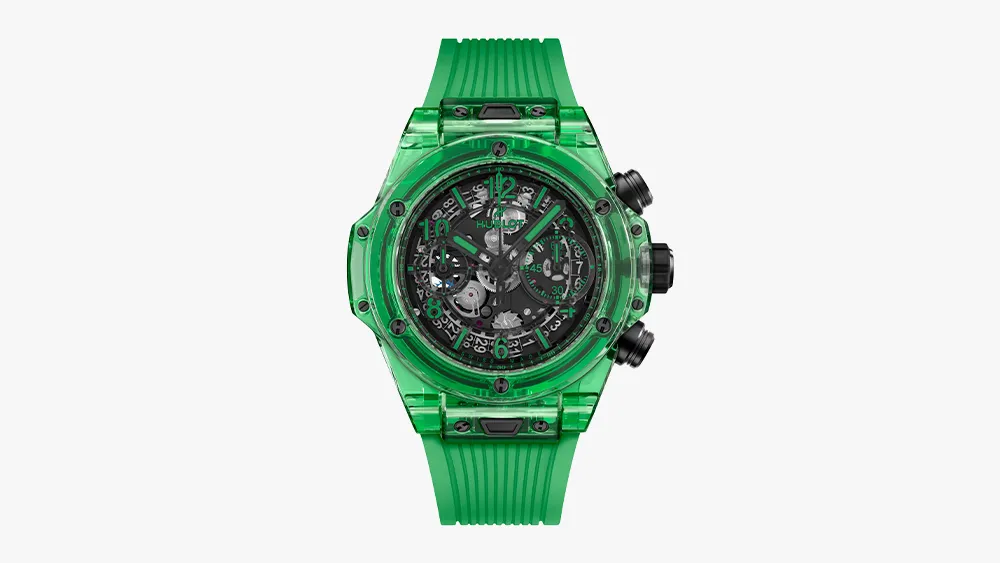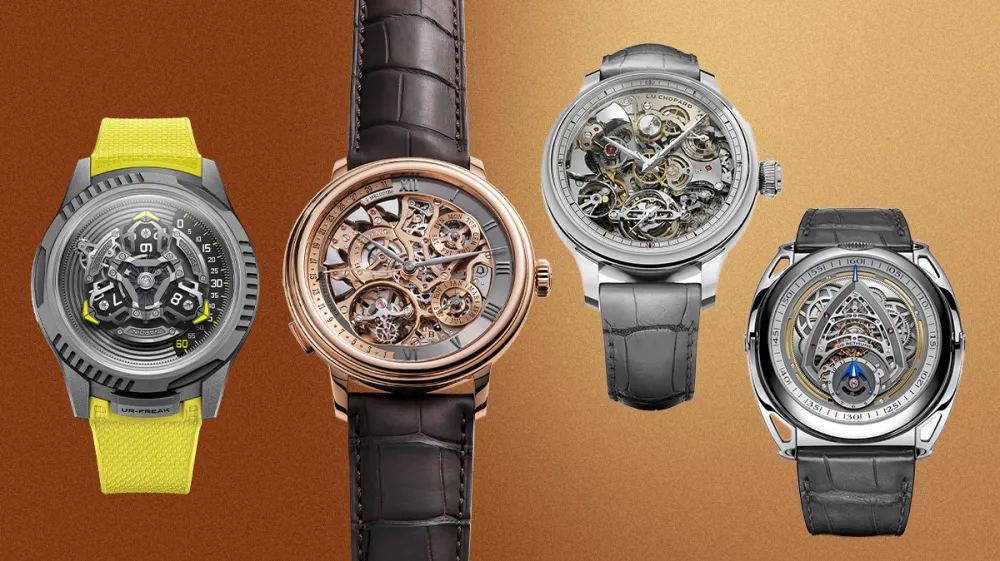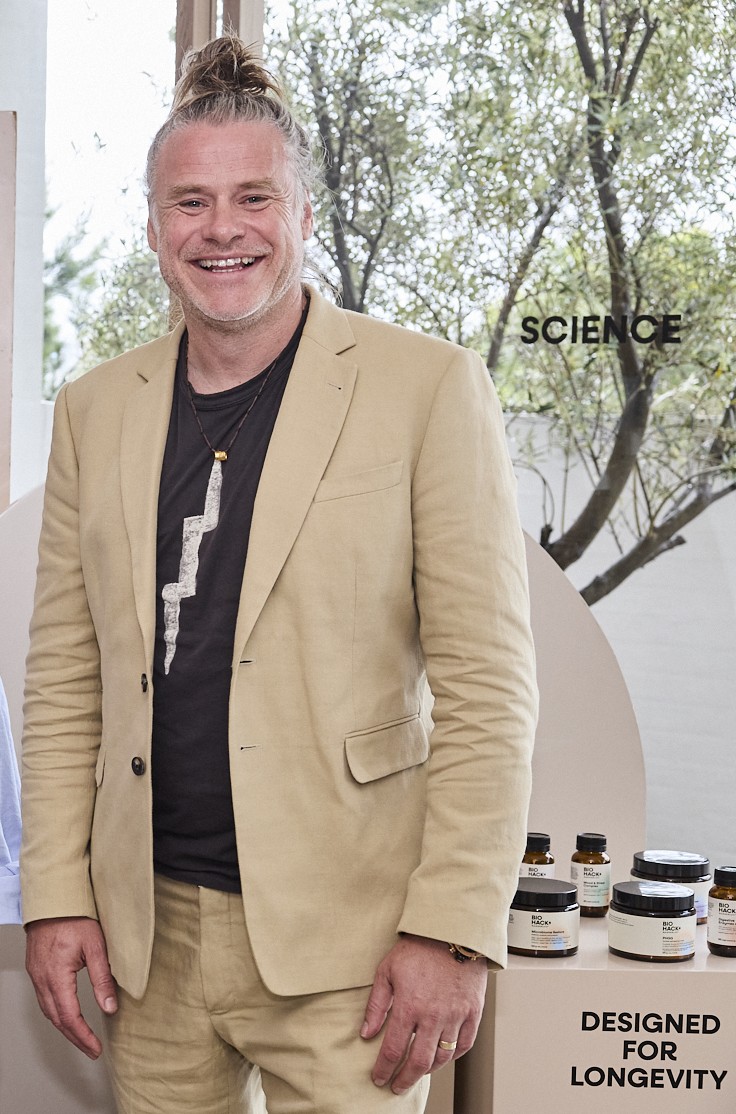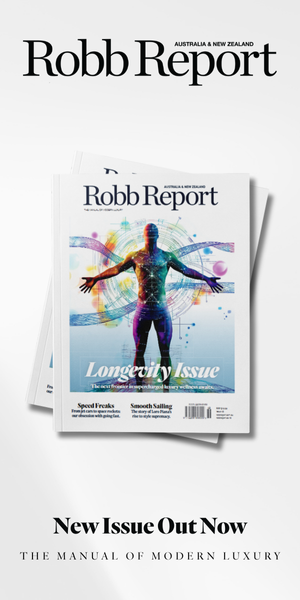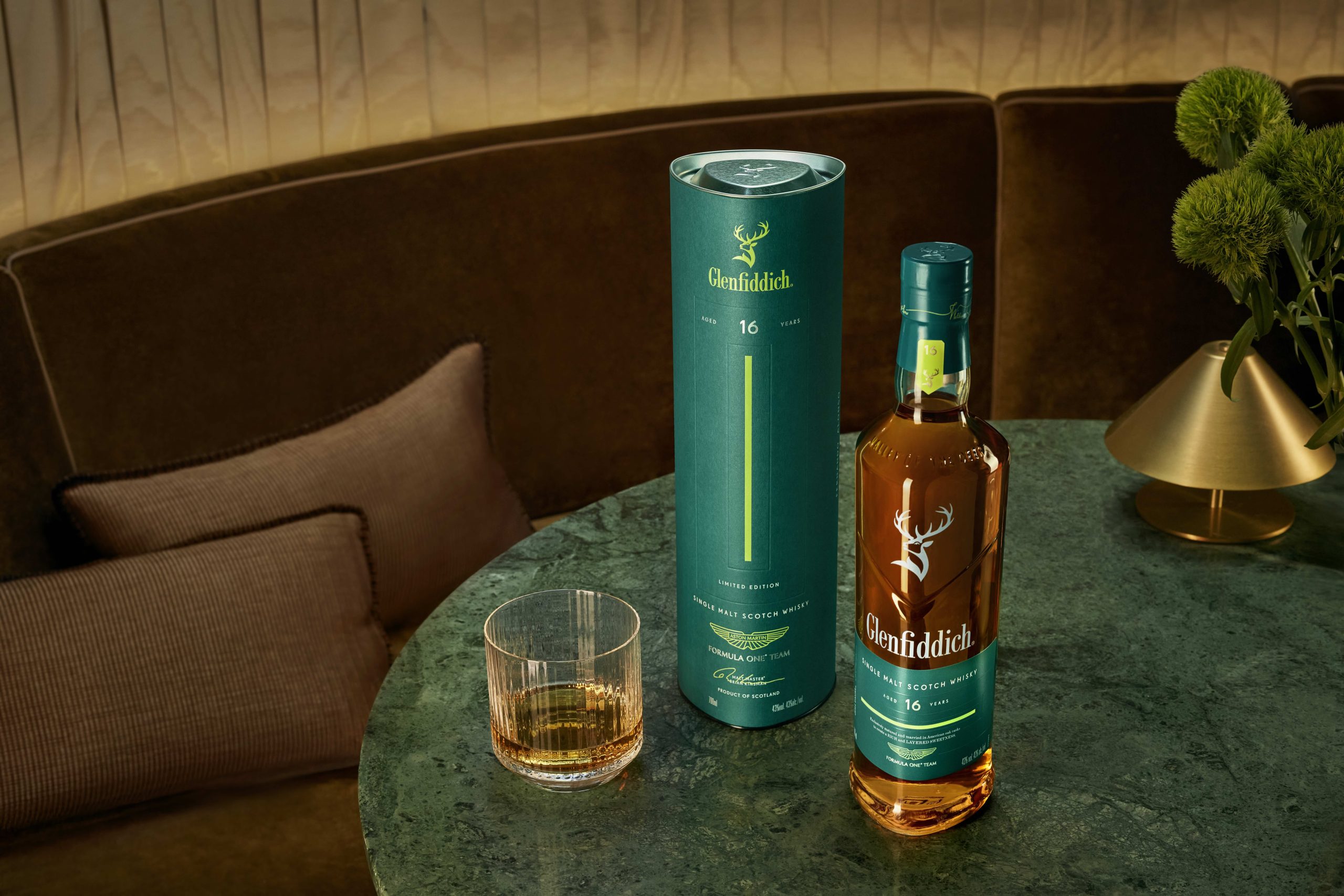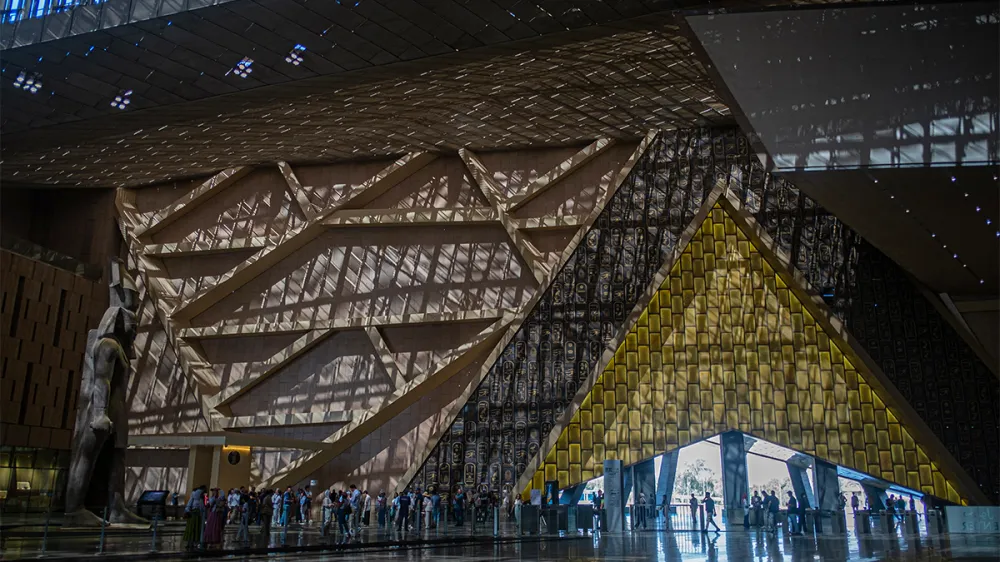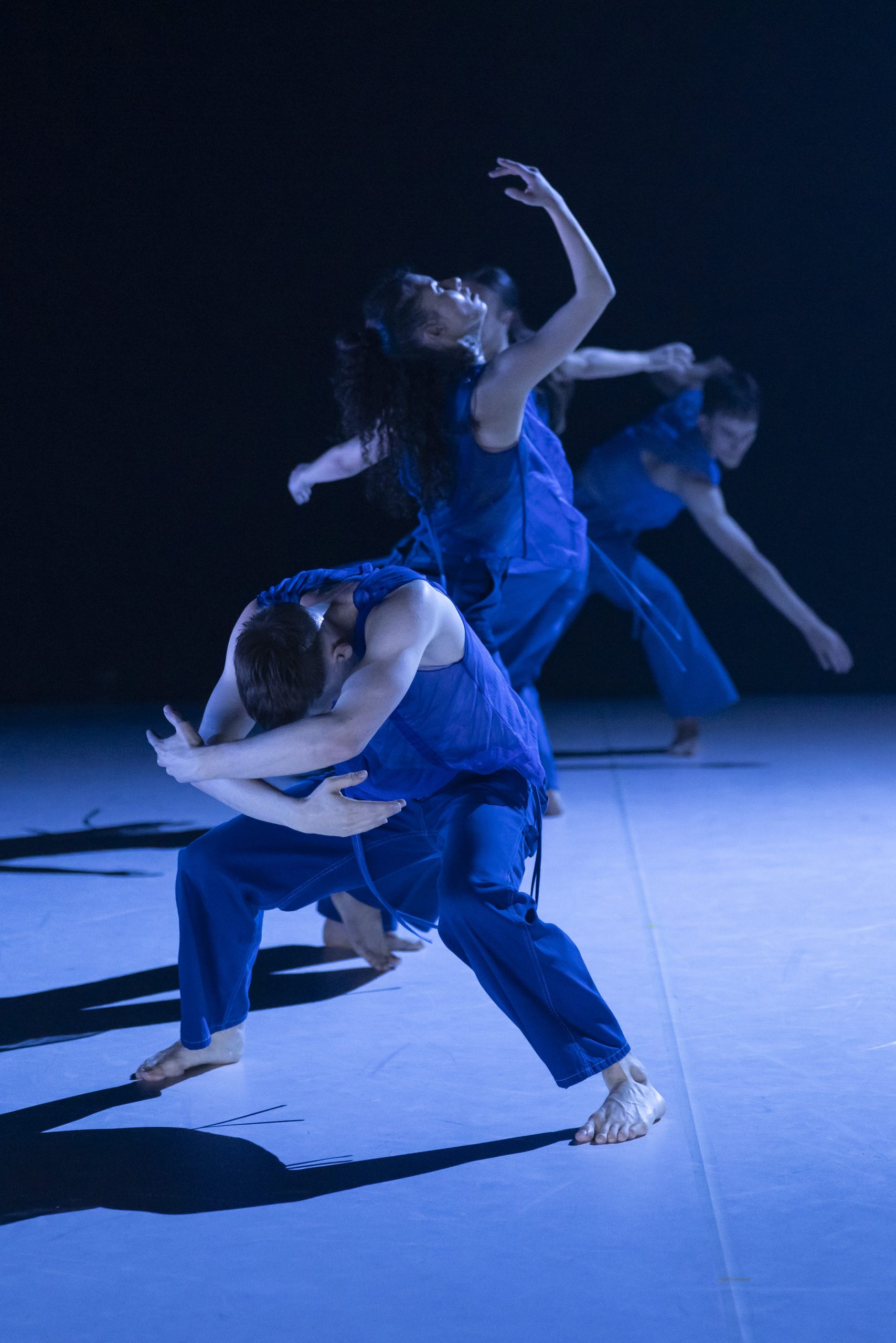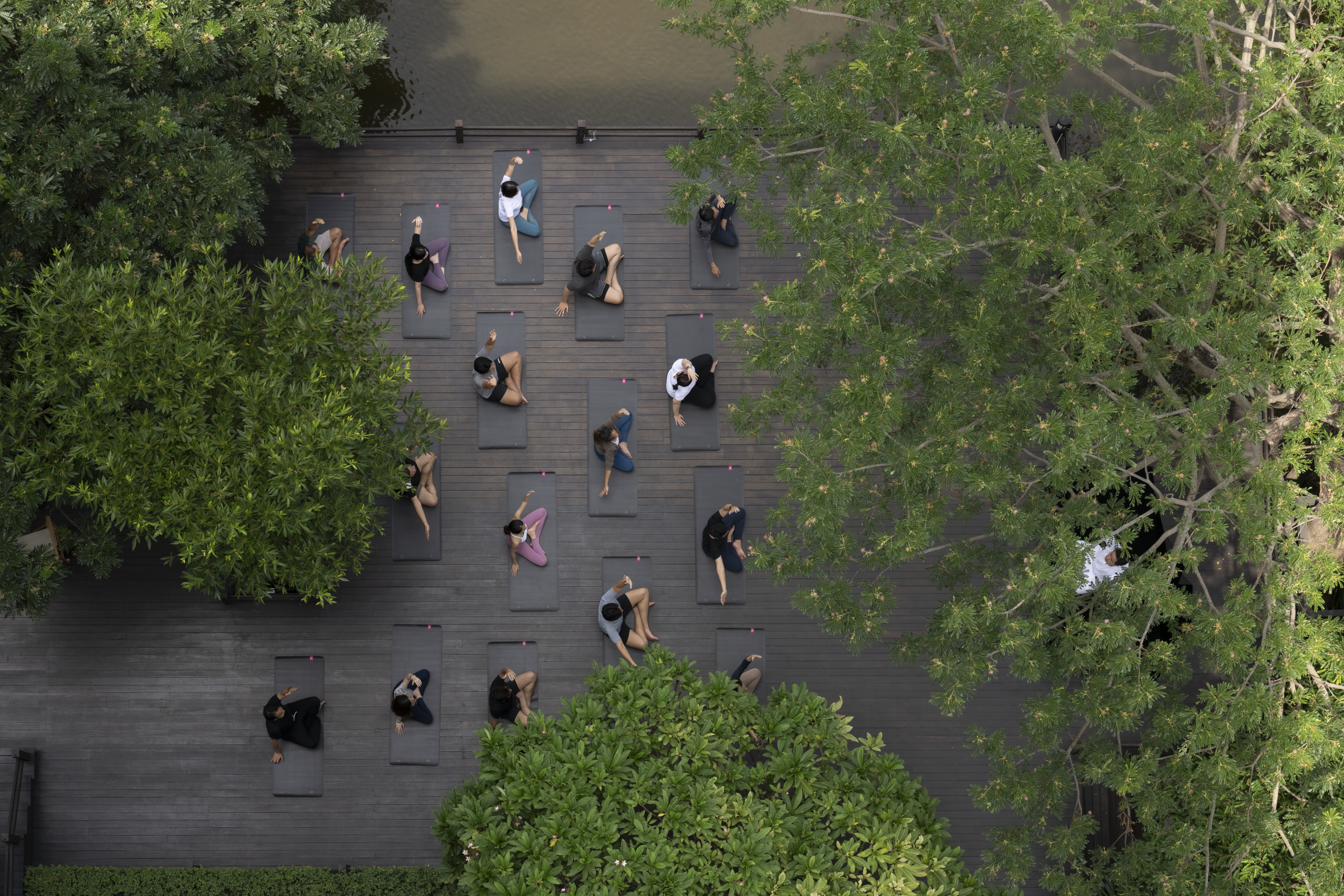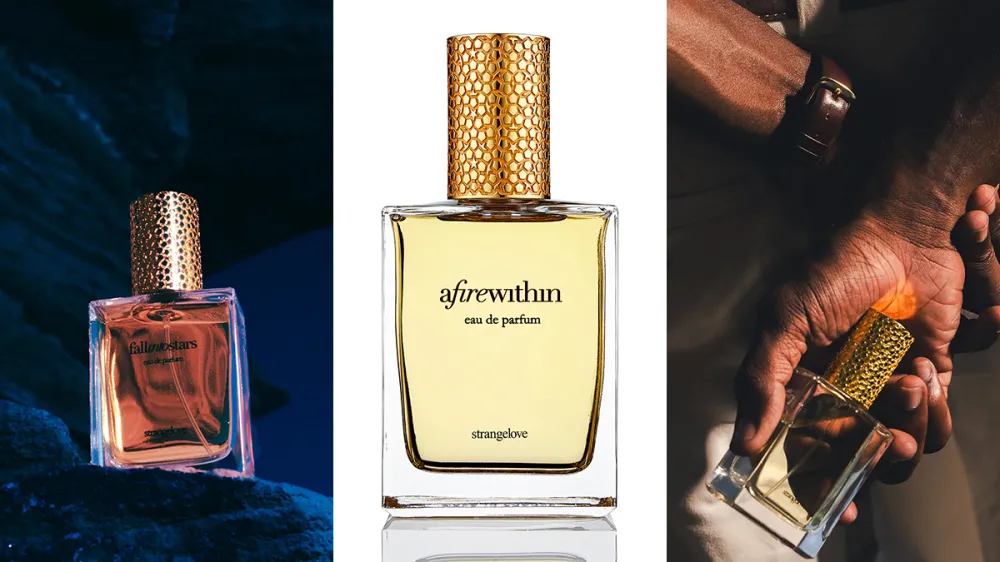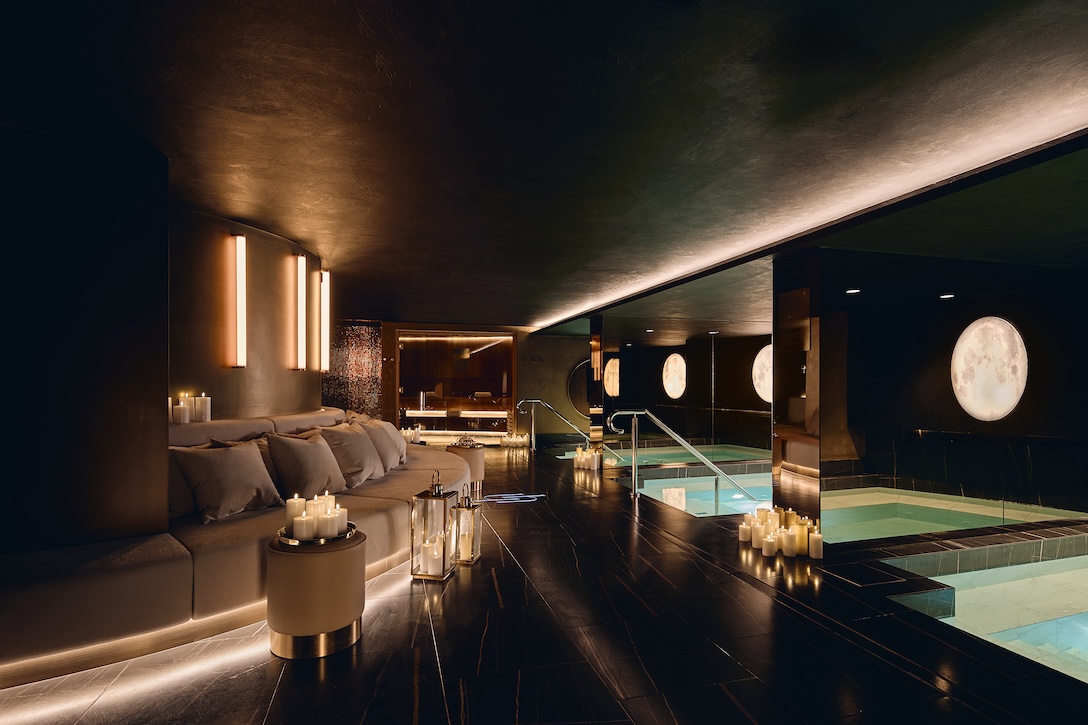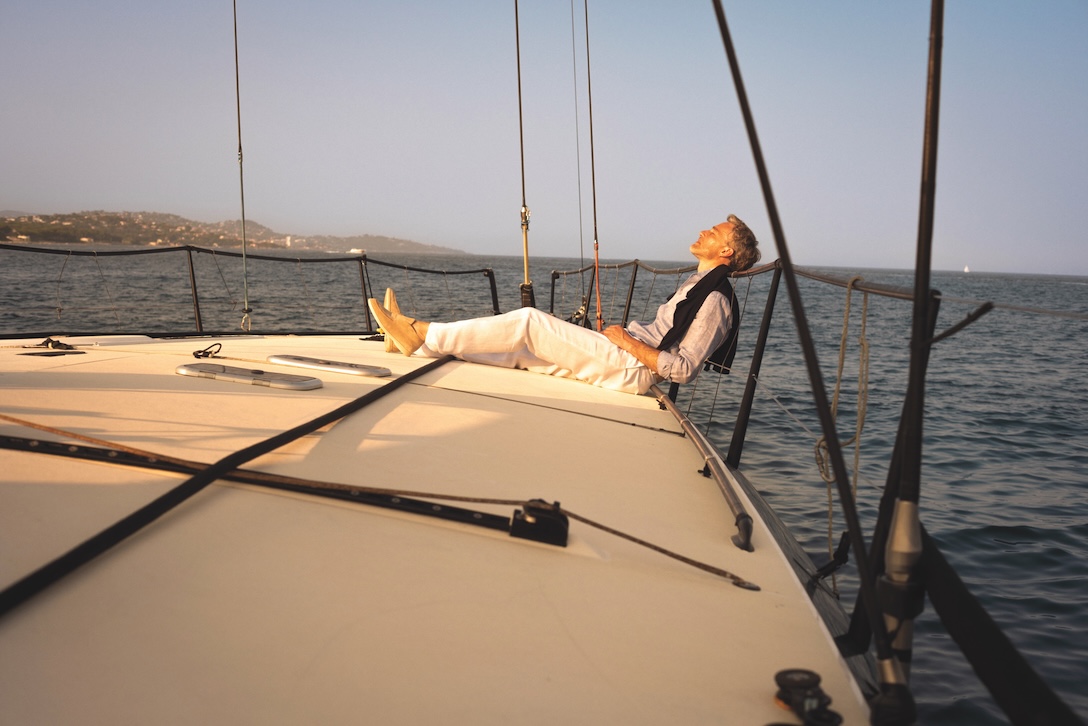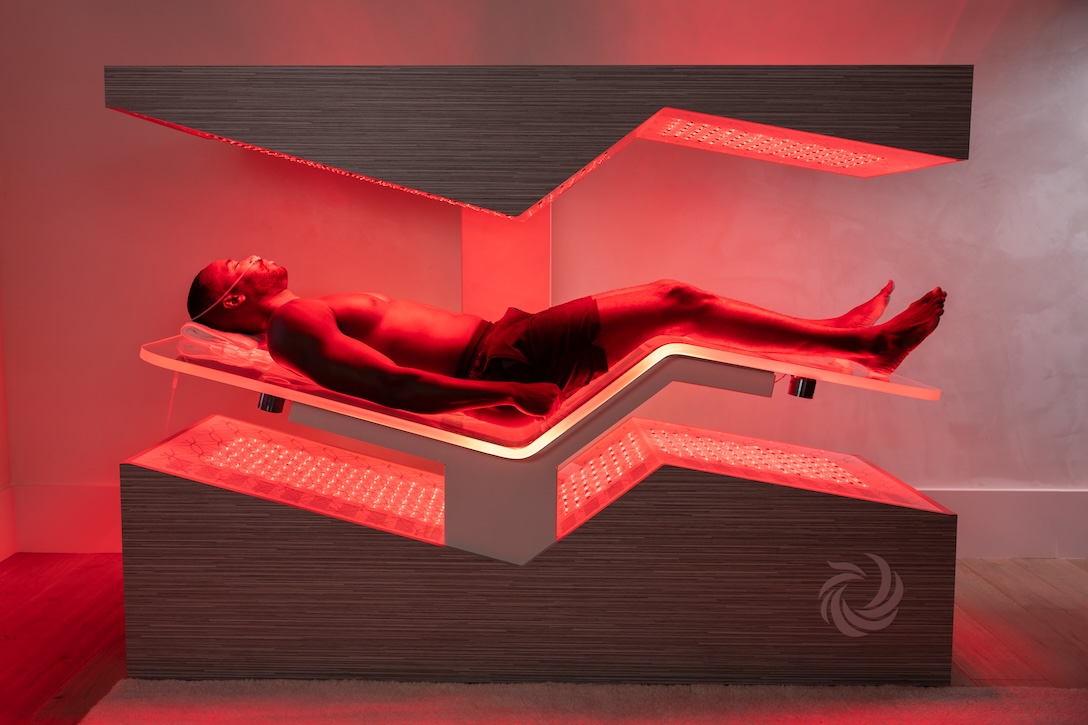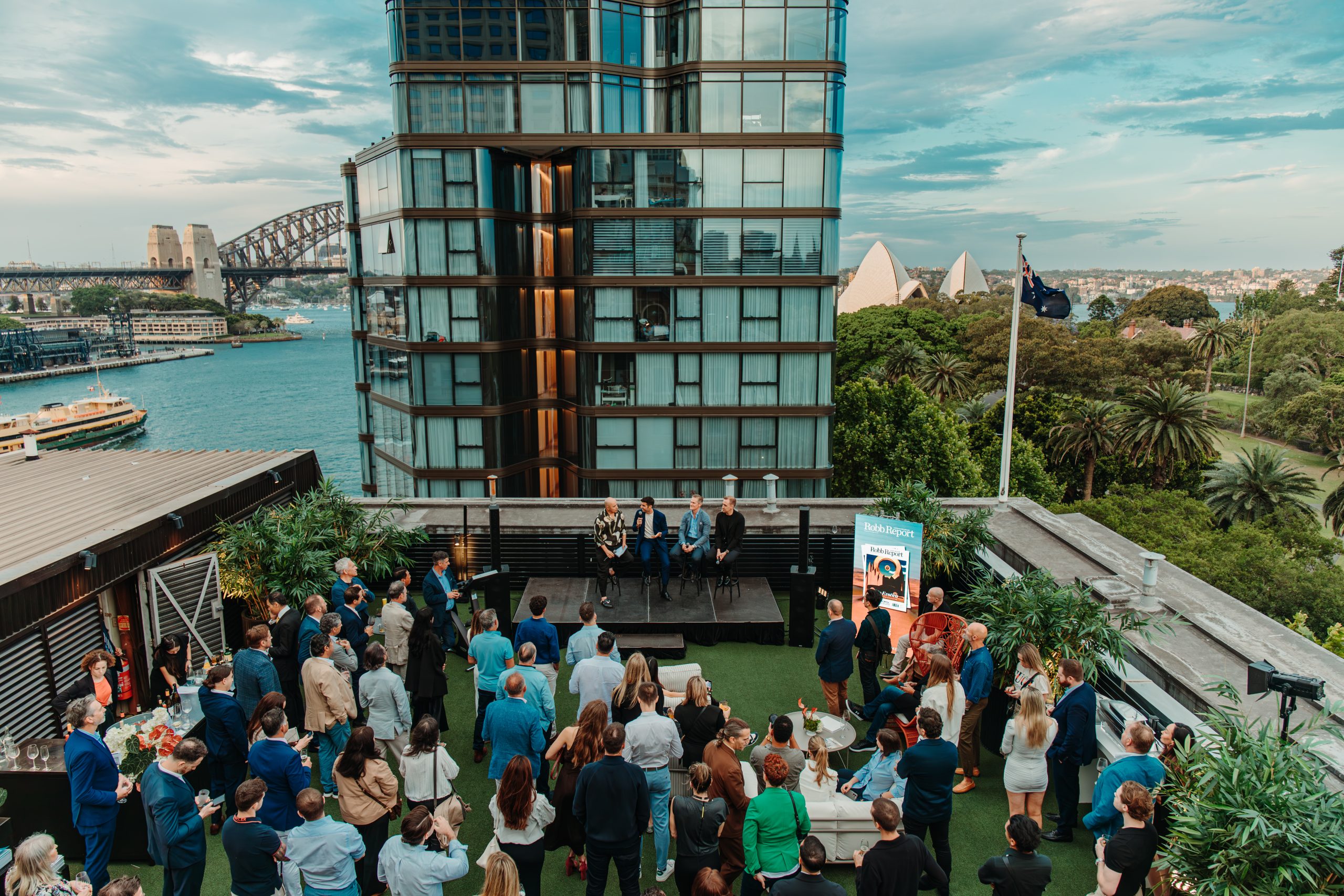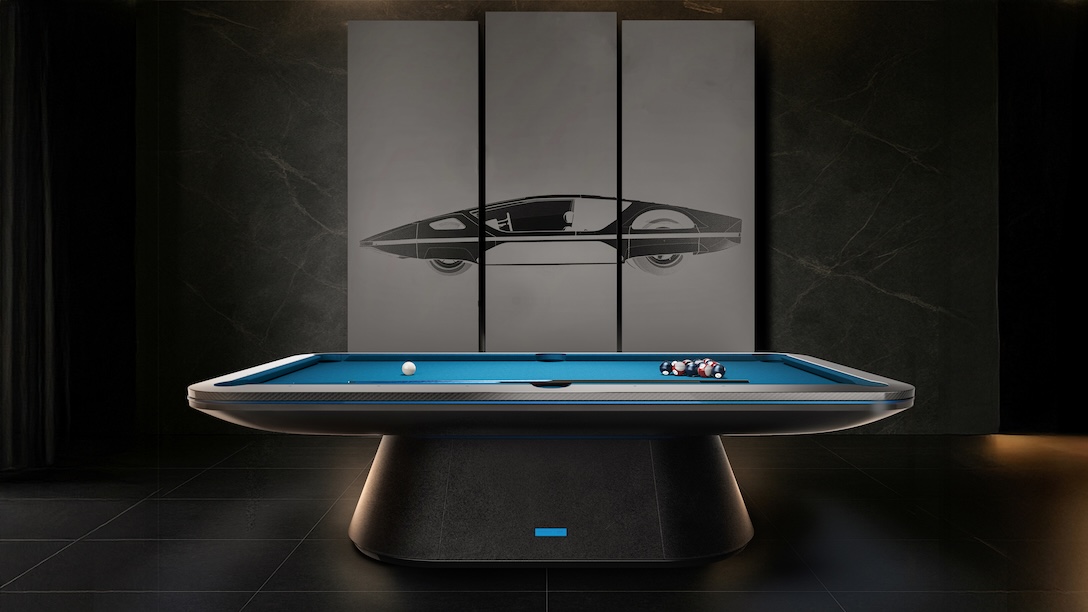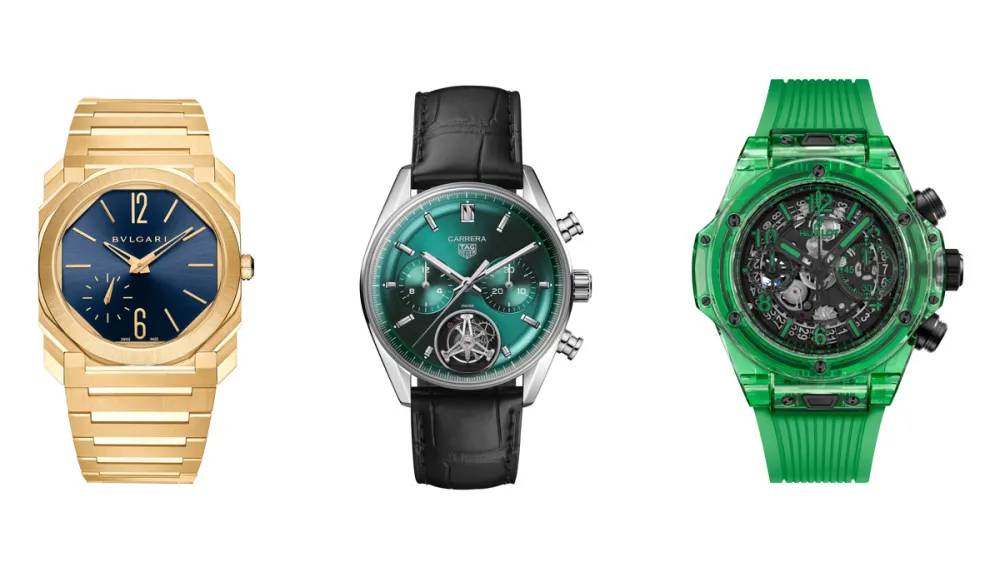
Bulgari, Hublot, and TAG Heuer Just Dropped Their New Watches for 2024
LVMH’s horological brands headed to Miami to introduced the year’s freshest models. Here’s a look at the best.
Related articles
LVMH Watch Week kicked off yesterday in Miami. The annual event, which began in 2019 in Dubai just ahead of the pandemic, has meant the luxury conglomerate is the first in the watch industry to launch new releases. It’s a wise and strategic move for the company to flex its timepieces in a major press moment, while the rest of the industry generally waits until Watches & Wonders in April in Geneva.
“The concept was actually founded by Bulgari, by [Jean] Christophe [Babin],” said Frédéric Arnault, the newly minted CEO of LVMH’s watch division, at a poolside cocktail event at the W Hotel. “Initially, it was to really kickstart the year. It started with three brands from LVMH: Bulgari, Hublot, and Zenith. I’m proud to say it grew over time from how successful it was. It’s a great moment for all of our watch brands. It shows the strength and ambition of the group, LVMH. It is such an important category in the luxury world.”
This year, the event included six brands under the watch division: Bulgari, Daniel Roth, Gérald Genta, Hublot, TAG Heuer, and Zenith. Notably absent were Louis Vuitton and Tiffany & Co., two of LVMH’s largest brands that carry watches. It’s no secret that watches are a big push at both, particularly Louis Vuitton, but rumor has it that they’ll join next year’s edition. As far as this year’s participants go, the releases were mostly subdued with tweaks to existing models in new dial colors or case materials, such as a new green Hublot Big Bang SAXEM or a new sunray blue dial for the 18-karat yellow gold Octo Finissimo. Others, like the Daniel Roth Tourbillon Souscription timepiece—a tour de force revival of the revered brand—had already been released to the press last year. Nevertheless, the week is more about drumming up a big press moment at the start of the year, ahead of every other watch conglomerate and brand in the industry. And, set against a backdrop of a white-pillared mansion on Miami’s ultra-exclusive Star Island overlooking the city’s turquoise waters glistening beneath the warm sun and 80 degrees in January, it certainly stands apart from the bustling stress of Watches & Wonders in chilly Geneva.
Hublot Big Bang Unico SAXEM Green
Hublot’s well-funded research and development division continues to make good on its commitment to find ways to add new colour to watchmaking’s most high-tech case materials, specifically ceramic and SAXEM, Hublot’s proprietary variation of sapphire crystal. Fans of the exuberantly colorful brand will remember last year’s launch of Sapphire Aluminum oXide and rare Earth Mineral, or SAXEM for short, in neon yellow. It’s a sapphire crystal-like substance that Hublot figured out how to infuse with a combination of minerals to create a fluorescent colour that glows like neon. This year it reappears in green, which is emerging as the year’s hottest color in watches. Like sapphire, SAXEM is transparent, so you can see the movement, the HUB1280 flyback chronograph, through the case side. For contrast, it is openworked and blackened, so the dial contrasts with the green case – calling to mind a popular look in jewellery design, the pairing of green garnet with blackened gold. The difference between sapphire and SAXEM, explains Hublot, is that Sapphire has a trigonal (three-sided) structure, while SAXEM has a cubic (four-sided) form.” Hence the more intense colour, like a gem with more facets. The material does not receive light, but creates the illusion of emitting it. It’s large size – 42mm – enhances the drama. SAXEM was first used in 2019 in a similar shade of emerald green on the Big Bang MP-11. An integrated rubber strap is perfectly matched to the case, as is the green lume on the hands. Hublot will make 100 pieces.
Price: Around$175,000, 100 pieces.
Case Material: SAXEM
Case Size: 42mm x 14.5mm
Hublot Classic Fusion Tourbillon Orlinski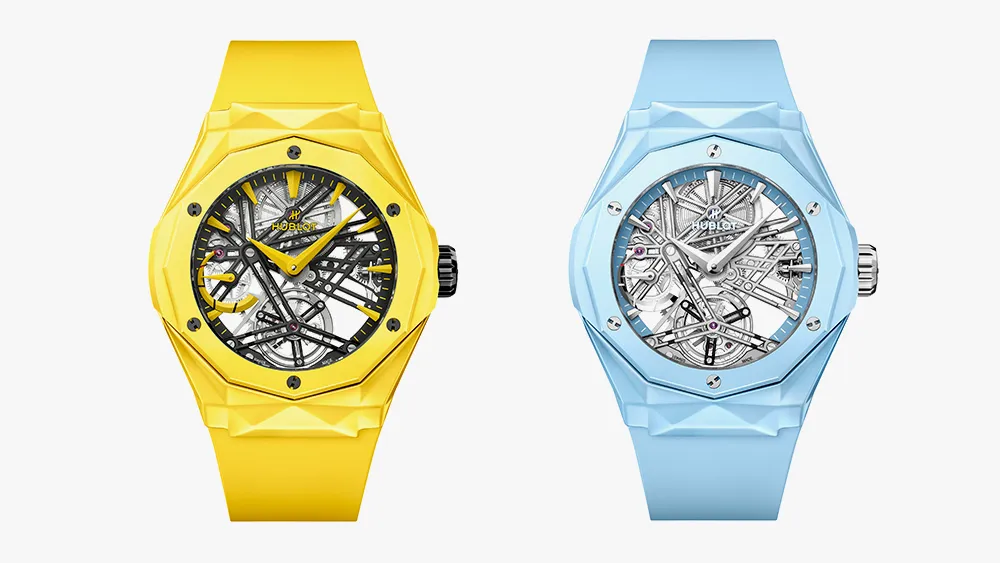
Hublot’s Classic Fusion Orlinski series has had a minimalist and muted aesthetic, with white or black dials and a slightly bolder royal blue ceramic version. This year it has been infused with a renewed sense of colour that doesn’t detract from the artist’s sculptural design so much as transform it. The design is stark and angular, with time only, plus seconds, leaving the faceted dial and bezel to deliver all the drama. This year the drama is in the colour. The Classic Fusion Tourbillon Orlinski appears in scorching-sun yellow or clear-sky blue versions, both infused in ceramic, inching them even closer to the dramatic pop art sculptures created by Hublot’s collaborator on the series, French artist Richard Orlinski. The architectural style of the watch carries over here to the openworked movement, the manually wound HUB6021 tourbillon, with faceted bridges coated in black PVD for the yellow version and silver rhodium for the blue version. There will be 30 pieces of each model.
Price: Around $143,000 pieces
Case Material: Ceramic
Case Size: 45mm x 10.6mm
Hublot MP-10 Tourbillon Weight Energy System Titaniu
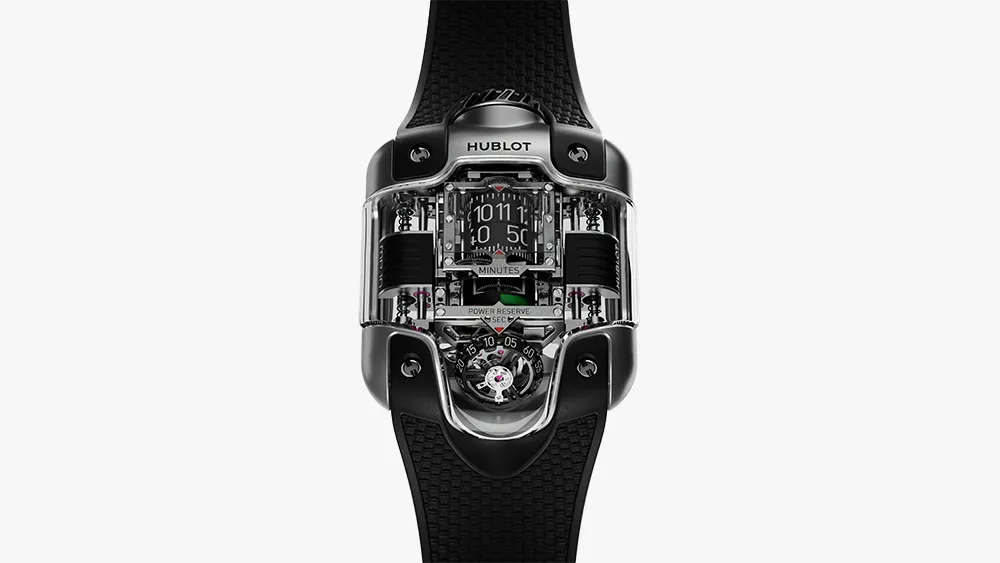
Hublot is a young brand, founded in 1980, compared to most top Swiss watch brands, which were founded about 100 years earlier. It therefore has a singular claim to post-modern watchmaking and design, free from the shackles of upholding the classical traditions of watchmaking. It has proposed instead to take watchmaking into the future. Its masterpiece line, or MP, thus has one goal: to reinvent existing complications. The MP-10, the brand’s tenth MP takes on the tourbillon. It has no dial, no hands and no oscillating weight (even though it’s automatic). The 592-component movement was five years in development and works on a system of aluminum rollers and a vertical winding system. Time is read from top to bottom on four constantly rotating displays: Hours on top, followed by minutes, a red/green power reserve disk, and lastly seconds, rotating on the 60-second tourbillon. The seconds take prominence over the tourbillon, since the escapement is angled at 35 degrees and thus largely out of sight. In case there is any misunderstanding about which functions are where, each is spelled out on bridges above or below each index. The case is made of two pieces – a middle and a back – in micro-blasted titanium, with a sapphire crystal wrapped on three inclined planes on three axes. Hublot has a patent pending for this configuration, its most complex to date. The rotor is not a rotor at all, since it doesn’t rotate. It works on a verticalised weight principle with two blocks of white gold that move up and down, winding the movement bidirectionally. Shock absorbers prevent them from colliding at each end. The system, which delivers 48 hours of power reserve, is also pending a patent pending. There are two crowns, neither of which rests in the traditional 3 o’clock position. The massive crown at 12 o’clock winds the watch. Time is set using a second crown nestled on the caseback side “to preserve the fluidity of the design,” explains the Hublot release.
Price: Around $400,000, 50 pieces
Case Material: Titanium
Case Size: 54.1mm x 41.5mm x 22.4mm
Hublot Spirit of Big Bang Jewellery
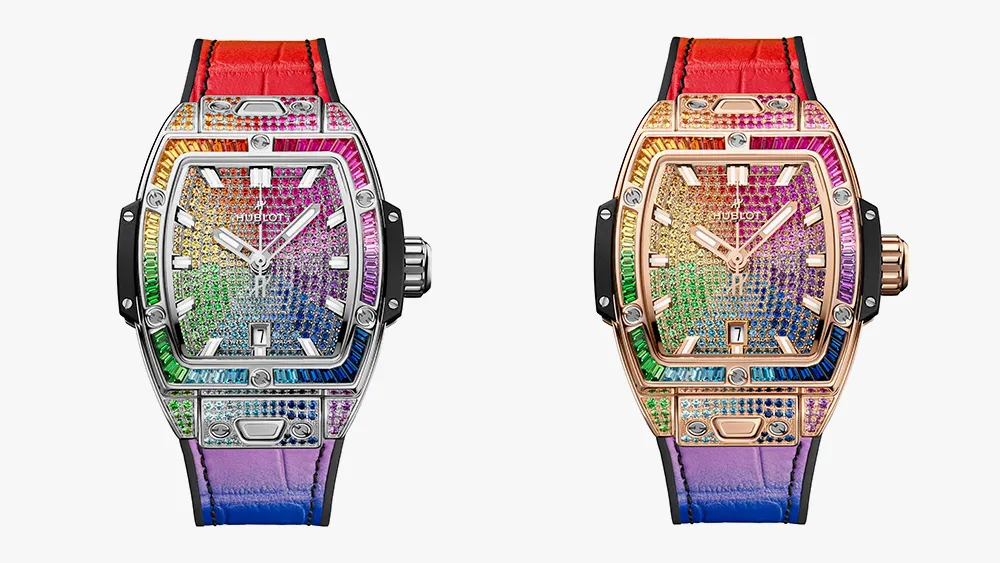
As a modern brand, Hublot has always had an uninhibited sense of the jewellery watch, more red-carpet bling than aristocratic classicism. This year’s Big Bang Jewelry collection includes a can’t-miss-it Rainbow model – the first of Hublot’s signature multi-colored sapphire pieces to appear in the barrel-cased Spirit of Big Bang collection. There are two versions, one in steel and the other in King Gold, Hublot’s proprietary warm red gold alloy. Each set with 493 multi-colored gems. Likewise, there are both steel and King Gold versions of the new Spirit of Big Bang Full Pavé showstoppers. Each is fully set with diamonds on the bezel, case, and dial, with a whopping 479 brilliant-cut gems totaling just over 2 carats. Hublot has even calculated the number of facets which adds up to: 27,782 per watch, with each of those facets reflecting light like a klieg light. They are accompanied by black or white rubber straps.
Prices:
Steel Full Pave: around $52,400
King Gold Full Pave: around $70,012
Steel Rainbow: around$110,200
King Gold Rainbow: $120,000
Case Material: King Gold, steel
Case Size: 32mm x 11.10mm
Bulgari Octo Finissimo
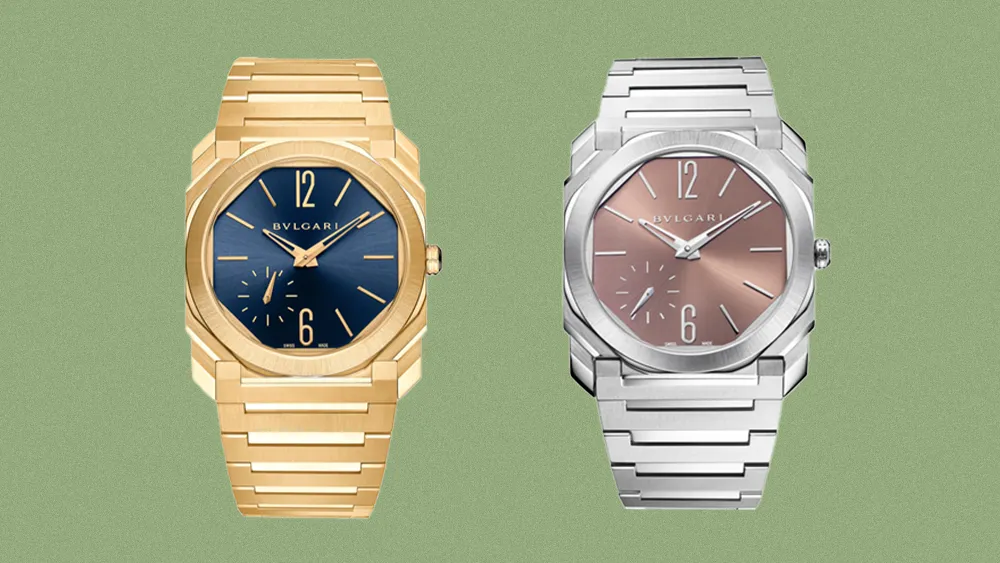
If these two models look familiar, that’s because they were officially launched in the U.S. market last year, but now Bulgari is announcing a global offering. The steel model with the Tuscan copper dial remains the same as the model that was initially released stateside last year in a limited run of 50. The 18-carat yellow gold model, however now comes dressed in a blue sunray dial. Its 2023 release in the U.S. came with a chocolate brown dial.There’s nothing groundbreaking here. This model has already done enough trailblazing—the Octo Finissimo has set eight world records. The steel model is the most appealing with the coolness of the metal paired with the soft warmth of copper, but while yellow gold might seem rather bold on a watch with such a wide bracelet it’s not as overpowering as you might assume in person. A female Bulgari representative who was wearing the piece on her wrist at LVMH Watch Week made a compelling case for the yellow gold version, while also proving that even at 40 mm, this watch’s ergonomics somehow make the sizing work even on smaller wrists.
Price: Around $68,912 in Yellow Gold and $20,143 in Steel
Case Material: 18-karat Yellow Gold or Steel
Case Size: 40 mm x 6.4 mm
Bulgari Lucea
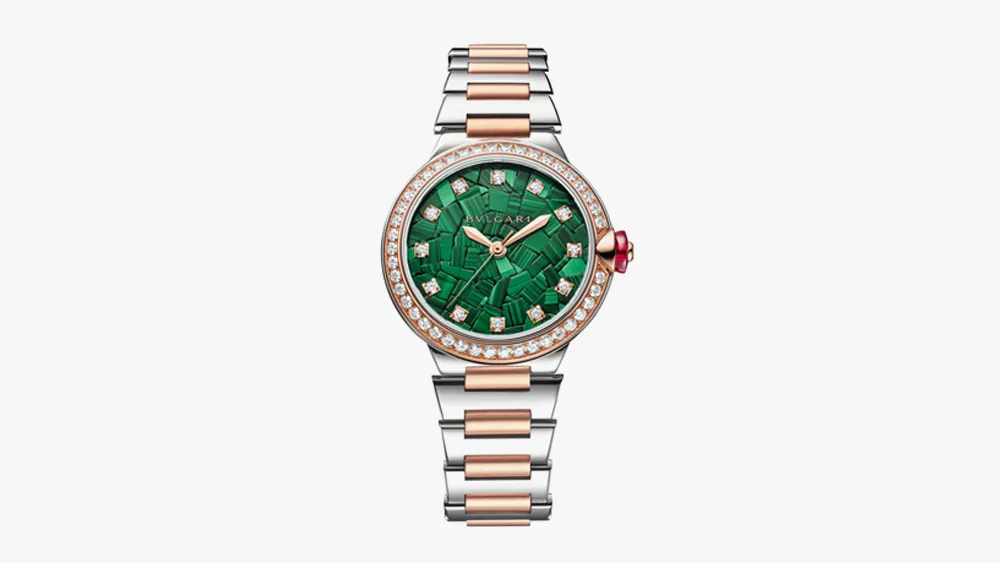
The Lucea collection is celebrating its 10th anniversary this year, so Bulgari naturally had to bring an ultra-special model to the table. The most striking new Lucea is the rich malachite dial version which was made with scraps of the stone material leftover from other watch models in the Bulgari manufacture. Instead of throwing away the tiny fragments, the company put them to use in a beautiful marquetry compilation. The varying hues of green create an arresting pattern accented by brilliant-cut diamond hour markers and encircled by a bezel adorned with 56 diamonds. The malachite pairs nicely with the two-tone case and bracelet in steel and 18-carat rose gold, as well as the ruby crystal crown protector. It is, by far, the most outstanding Lucea release of the year (so far).
Price: TBC
Case Material: Steel and 18-karat Rose Gold
Case Size: 33 mm x 9.6 mm
La Fabrique du Temps X Gérald Genta Manufacture Calibre GG-001
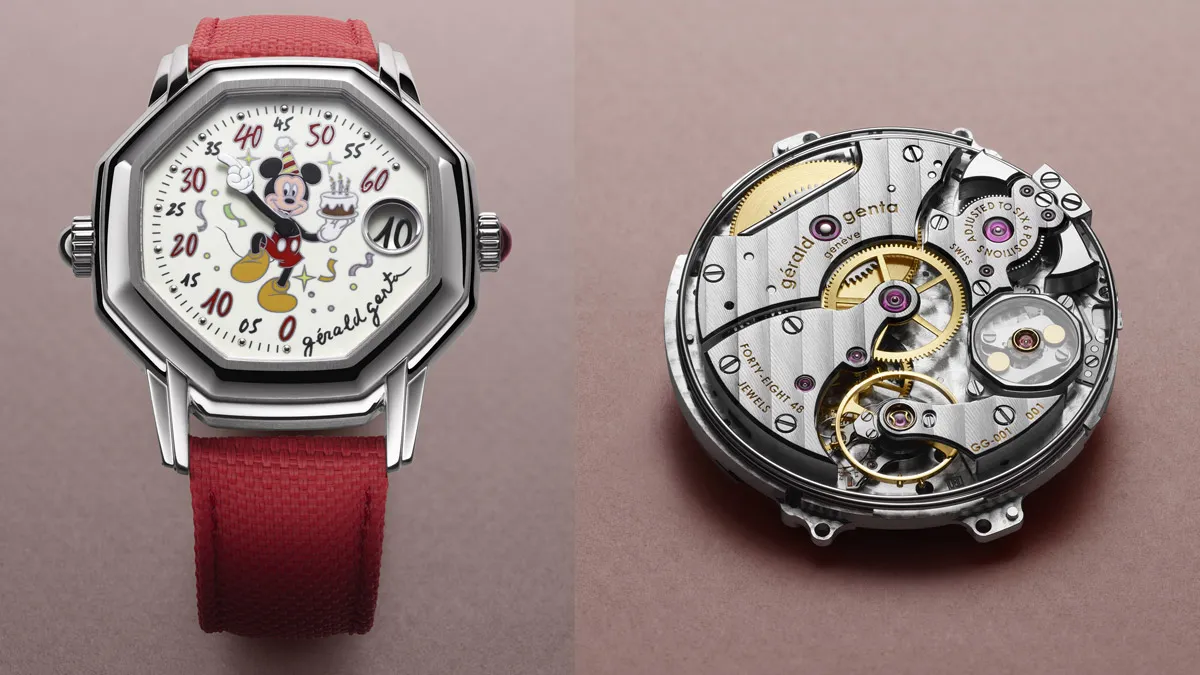
Forty years after famed watch designer Gérald Genta first defied the highly traditional watch industry by putting Mickey Mouse on a watch dial, La Fabrique du Temps is resurrecting this playful design as it relaunches the brand. And for those of you who scoff at the idea of a Disney-themed timepiece, kindly consider the type of watch we’re talking about: The new GG-001 is no simple time-only piece, but a minute repeater with a jump hour and retrograde minutes display developed by the horological illuminati at La Fabrique du Temps itself. Housed in a 32.4mm case that measures just 6.91mm thick, it has an impressive 80-hour power reserve and a beautiful dial graved by everyone’s favourite mouse: At 3 o’clock is a magnified jump-hour window, while Mickey’s left arm serves as the minute hand along a retrograde track running along the dial’s periphery. Playful yet subtle, this creative integration of multiple complications is an impressive feat of watchmaking — one that will be appreciated by both die-hard “watch nerds” and those whose taste runs more toward compelling aesthetics. (Not to mention by Disney fans everywhere!)
Price: TBD
Case Material: Platinum
Case Size: 40 mm
La Fabrique du Temps X Daniel Roth Tourbillon Souscription
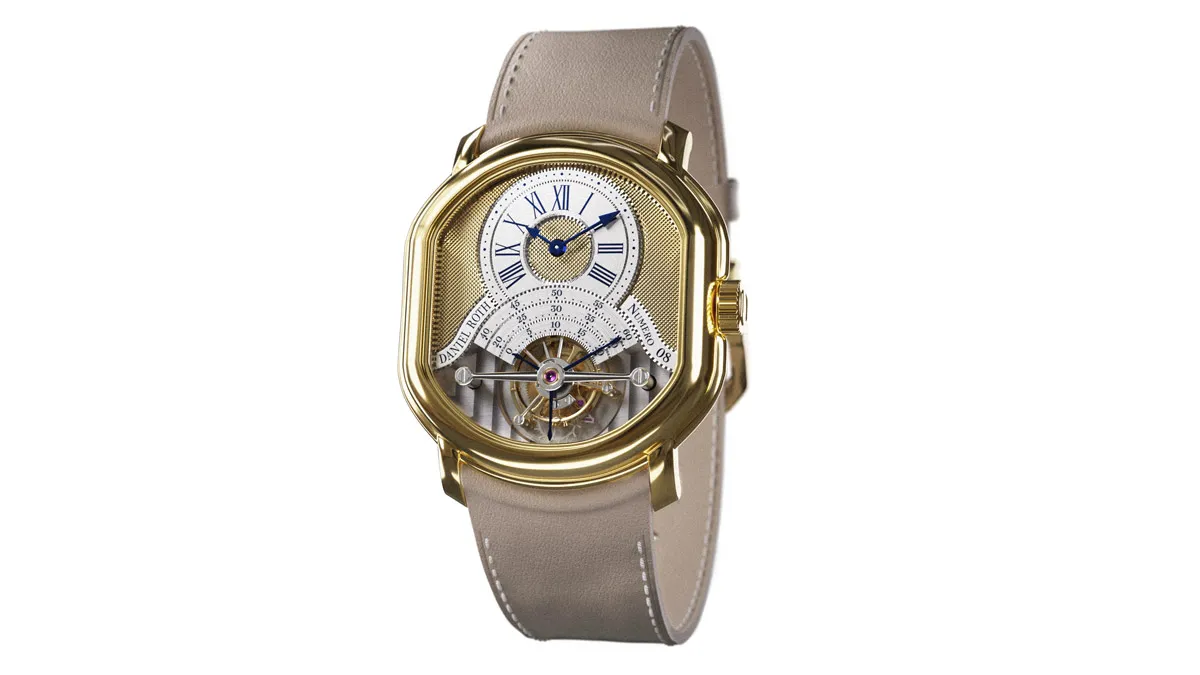
Since 2000, the Daniel Roth brand has been owned by Bulgari, which was itself acquired by LVMH in 2011. Now, the eponymous maison founded by the famed French-born watchmaker has been revived with the involvement of La Fabrique du Temps, the LVMH-owned movement manufacture founded by star horologists Michel Navas and Enrico Barbasini. The first product to see the light of day will certainly delight Daniel Roth fans: The new Tourbillon Souscription is an homage to the ref. 2187/C187, Roth’s first model. Housed in the watchmaker’s famed double-ellipse case, it takes inspiration from the designs of 18th/19th-century watchmaker Abraham-Louis Breguet, with exquisite finishing and the integration of remarkable complications. Extremely limited in production, the new timepiece features a solid-gold guilloché dial, a new in-house movement, and an impressively thin case depth of just 9.2mm. With its visible tourbillon cage and retrograde display, it’s truly a piece of horological art, and bodes well for the reconstitution of this important marque.
Price: TBD
Case Material: 18K yellow gold
Case Size: 38.6mm
TAG Heuer Plasma Diamant
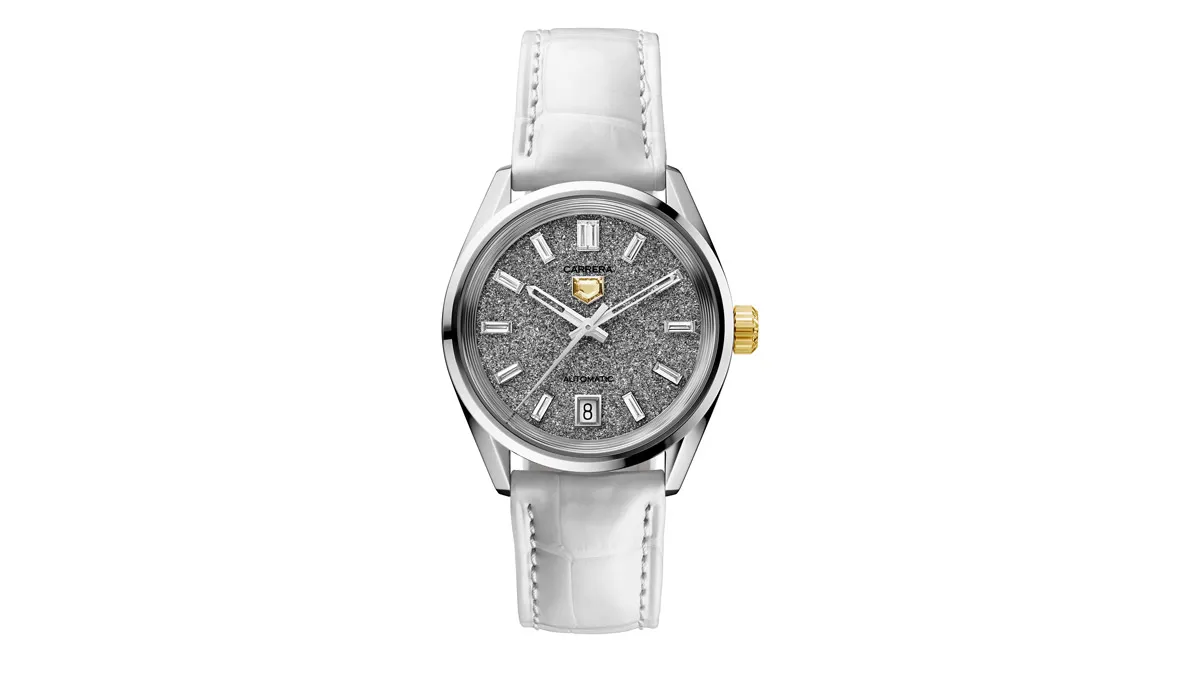
Just when you think the cutting edge of tool watch design means a tourbillon in your chronograph, TAG Heuer hits you with one of these: A sports watch positively encrusted in diamonds like the bottom of a caïque off the coast of Paros. The new TAG Heuer Carrera Date Plasma Diamant is merely the latest in a series of timepieces featuring lab-grown diamonds, whose uniform colour is achieved via a Chemical Vapor Deposition technology that the brand calls “Plasma.” In this instance, rather than set diamonds throughout the case of a larger 44mm watch such that of as last year’s Carrera Plasma Diamond d’Avant Garde, TAG Heuer has taken its 36mm, time-only version of the Carrera and jazzed it up: Fashioned from white gold, it features a 2.9-carat polycrystalline dial with baguette-cut diamond indices; a yellow gold TAG Heuer shield logo; and a 1.3-carat yellow diamond crown. The interplay between the case material, sparkling dial, and bright pops of yellow is striking without being gaudy — a difficult feat to achieve with this many precious stones.
Price: TBD
Case Material: White gold
Case Size: 36mm
TAG Heuer Carrera Chronograph Tourbillon
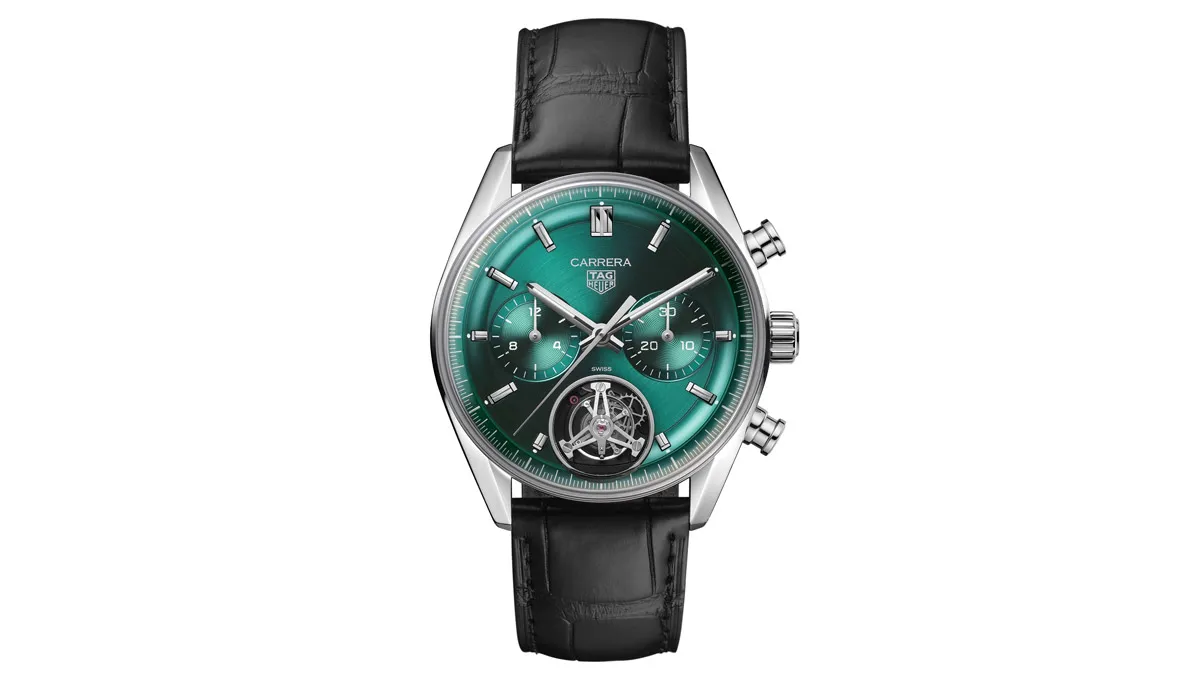
Launching alongside the aforementioned “Dato” model is a similarly teal-colored Carrera Chronograph in Tourbillon form, with a dual-register chronograph layout accompanied by Abraham-Louis Brguet’s famed invention visible at 6 o’clock. Developed by the famed French watchmaker in the early 19th century, the tourbillon is a horological device that places the movement’s escapement and balance wheel in a rotating cage, which helps negate the effects of gravity on a pocket watch movement. Nowadays, the inclusion of a tourbillon is a way for a watch company to show its expertise in movement construction, which TAG Heuer does here to good effect. Joined by 30-minute and 12-hour chronograph totalizers and easily visible beneath a curving “glassbox” sapphire crystal, the tourbillon in question is part of the TAG Heuer Calibre TH20-09 movement, which features bi-directional winding and a high level of finishing. Housed in a 42mm stainless steel “glassbox” Carrera case and paired to a black alligator leather strap, the TAG Heuer Carrera Chronograph Tourbillon is a high-end riff on a beloved sports watch.
Price: around $36,4300
Case Material: Stainless steel
Case Size: 42mm
TAG Heuer Carrera Chronograph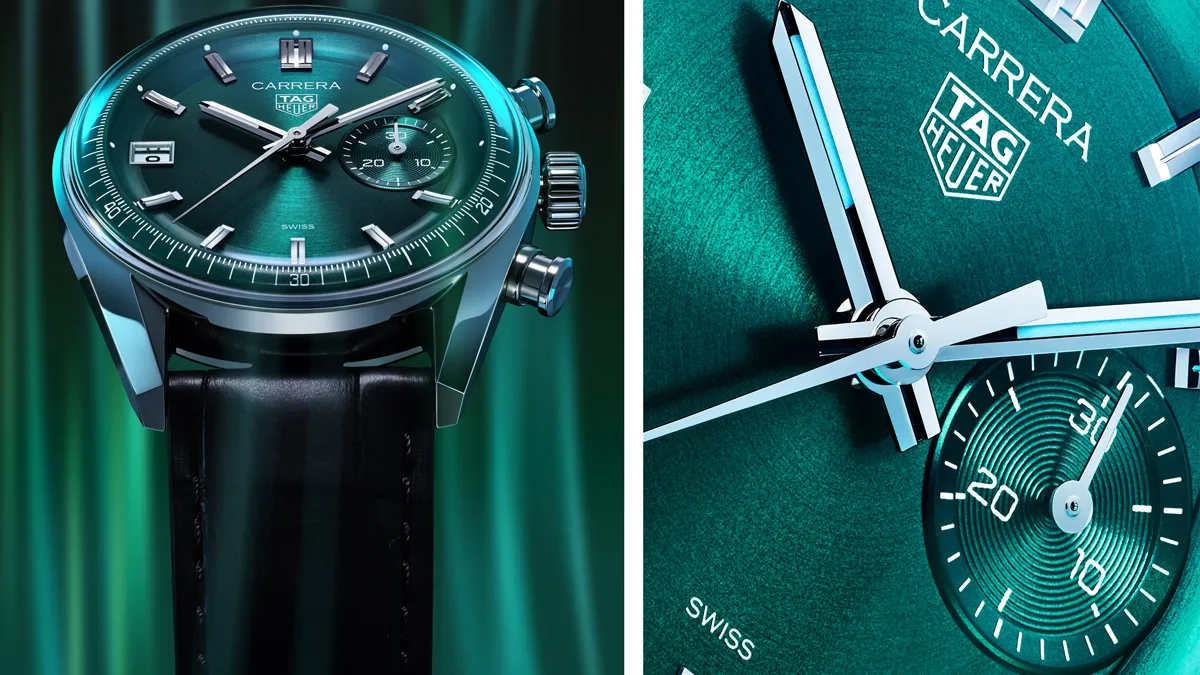
Jack Heuer, great-grandson of company founder Edouard Heuer, launched his famous racing chronograph in 1963, naming it after the Carrera Panamericana, a notoriously dangerous road race that took place in Mexico in the early 1950s. (And which also inspired the nickname of a certain Porsche.) Since then, the Carrera has taken on many guises, receiving a complete refresh in the form of the (still relatively new) “Glassbox” references launched in 2023 — just in time for the model’s 60th anniversary. This year, TAG Heuer is reviving a perennial fan favorite in the form of a new “Dato” model, which features a single, 30-minute chronograph totalizer at 9 o’clock and a date window at 9 o’clock. Hearkening back to a moderately rare Carrera variant from 1968, the new chrono marks the first time this unique date arrangement has appeared within the “Glassbox” case, which measures 39mm and features a curved inner flange housing a 1/5th-second track, all of which is enveloped by a gently curving “glassbox” crystal. With its striking, teal green dial and pared-down aesthetic, it’s sure to bridge the gap between fans of vintage Heuer and more casual watch buyers.
Price: Around $9,900
Case Material: Stainless steel
Case Size: 39mm
Zenith Chronomaster Original Triple Calendar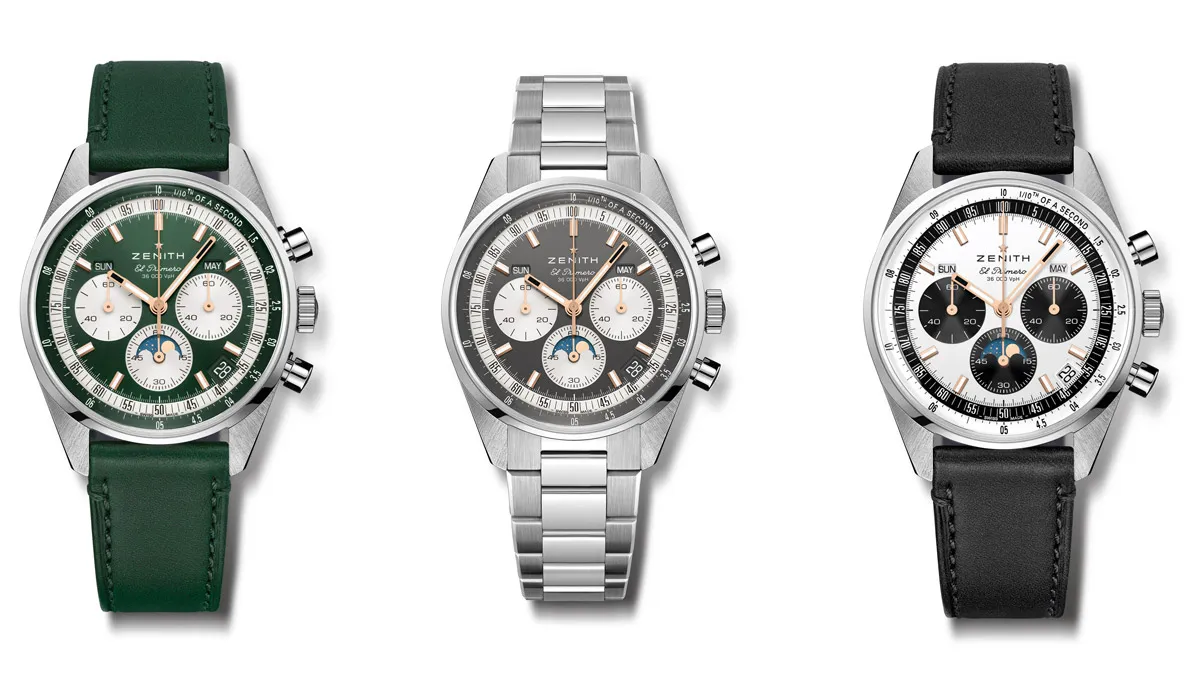
Most watch brands, when they announce the re-issue of a vintage design, are quick to include a note that while the design may be true to the original, the watch now contains a modern, in-house movement. In Zenith’s case, the movement was already there. The high-frequency El Primero calibre contained in the new Chronomaster Original Triple Calendar is a direct evolution of the one designed in 1969. In fact, the original El Primero movement was designed to accommodate triple calendar and moon phase functions right from the very beginning. Zenith made a small series of 25 prototypes in 1970 as a proof of concept, but since the chronograph was more popular, the triple calendar wasn’t produced commercially until later in the 1970s. The homage version is a tribute to the original movement, and its design is true to the signature A386 chronograph case design from 1969. The dial architecture mirrors the chronograph design codes – from a distance, you might have to do a second take to notice the Triple Calendar is not a chronograph-only. Days of the week and months are displayed in subtle windows above the east/west subdials – with small seconds at 9 o’clock and 60-second counter at 3 o’clock. The date window is in the traditional El Primero position at 4:30, and the moonphase display is incorporated right into the chronograph’s 60-minute counter at 6 o’clock. The El Primero 3610, runs at 36,000 vph to deliver a true 1/10th of a second chronograph function. Even with the addition of the complete calendar, it has a power reserve of approximately 60 hours. There are two regular versions, one with a sporty silvery-white panda opaline dial with black counters and 1/100th of a second scale, and an opaline slate-gray dial with silvery-white counters and scale that is directly inspired by the small series of El Primero triple calendar prototypes from 1970. A third, boutique-only variant has a sunburst olive-green dial. All have rose gold-tone applied baton markers and hands, to match the polished rose gold moon.
Prices: Around $21,055 for steel with metal bracelet (including boutique edition) and around $8,847 for steel with calfskin strap (including boutique edition)
Case Material: Stainless steel
Case Size: 38mm
Zenith Chronomaster Sport
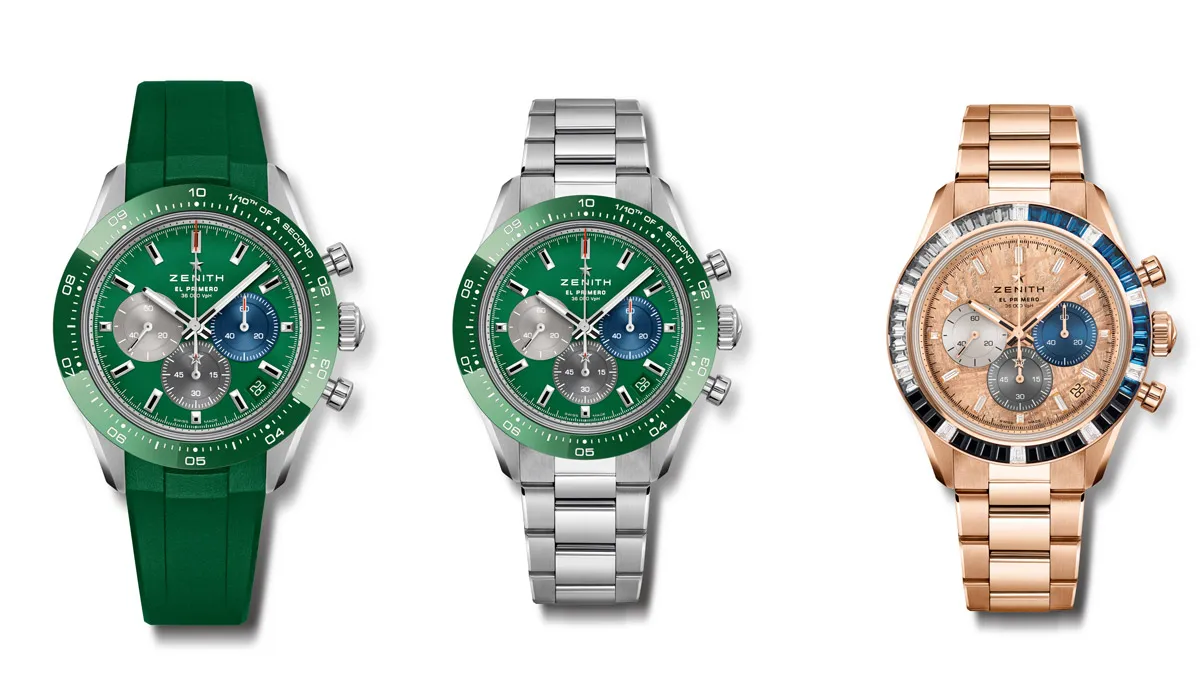
Having perfected the El Primero movement over the past 55 years, Zenith is now ready to have a little fun with the design of its flagship chronograph – but not so much that it obliterates the signature look. Two new versions include a first-ever gem-set Chronomaster Sport and an all-green model with a first-ever green ceramic bezel. Both models retain the signature tri-colour subdials of the Chronomaster in the familiar shades of gray and blue. The background dial of the green version is lacquered green to match the ceramic bezel and there’s a green FKM rubber strap to switch out the steel bracelet. The green is a vibrant, almost neon colour that is emerging as a strong watch colour, and it works surprisingly well with the tri-colour subdials. On the jewelled Chronomaster Sport, Zenith leans in even closer to the tri-colour aesthetic by setting the bezel with baguette-cut gems to match the subdials. There are white diamonds, black spinels (which read dark grey), and grey and blue sapphires. The dial is meteorite in the so-called “Windmanstätten” pattern (with long mineral crystals in geometric patterns), treated in a warm golden colour that matches the 18k rose gold case and bracelet. It’s a very dressy version of the Chronomaster Sport that dovetails with the ongoing trend toward dressing up sports watches and sporting up dress watches, which often cry out for definition: are sporty dress or dressy sport watches? The tri-colour chronograph registers, pump pushers, and El Primero 3600 movement tend to emphasise the sporty side of this one, but the precious gems and gold case elevate the watch to somewhere well beyond the race track. It’s your call.
Prices: Around $16,999 for Chronomaster Sport Green on bracelet; TBC for Chronomaster Sport Green on rubber strap and around $149,000for 18k rose gold Chronomaster Sport (boutique only)
Case Material: Chronomaster Sport Green, stainless steel; Chronomaster Sport 18-carat rose gold
Case Size: 41mm
Subscribe to the Newsletter
Recommended for you
Blancpain Returns to High Horology With the $3 Million Grande Double Sonnerie
With 21 patents and over 1053 parts, is this the Blancpain grail watch that collectors have been waiting for?
By Thor Svaboe
December 4, 2025
The 18 Coolest New Watches That Dropped in November
Blancpain, De Bethune, Vacheron Constantin and 11 other watchmakers debuted stylish new wristwatches this month.
December 3, 2025
You may also like.
You may also like.
Radek Sali’s Wellspring of Youth
The wellness entrepreneur on why longevity isn’t a luxury—yet—and how the science of living well became Australia’s next great export.
Australian wellness pioneer Radek Sali is bringing his bold vision for longevity and human performance to the Gold Coast this weekend with Wanderlust Wellspring—a two-day summit running 25-26 October 2025 at the RACV Royal Pines Resort in Benowa. Sali, former CEO of Swisse and now co-founder of the event and investment firm Light Warrior, has long been at the intersection of wellness, business and conscious purpose.
Wellspring promises a packed agenda of global thought leaders in biohacking and longevity, including Sydney-born Harvard researcher David Sinclair, resilience pioneer Wim Hof, performance innovator Dave Asprey and muscle-health expert Gabrielle Lyon. From immersive workshops to diagnostics, tech showcases, and movement classes, Sali aims to make longevity less a niche pursuit for the elite and more an accessible cultural shift for all. Robb Report ANZ recently interviewed him for our Longevity feature. Here is an edited version of the conversation.
You’ve helped bring Wellspring to life at a moment when longevity seems to be dominating the cultural conversation. What drew you personally to this space?
I’ve always been passionate about wellness, and the language and refinement around how we achieve it are improving every day. Twenty years ago, when I was CEO of Swisse, a conference like this wouldn’t have had traction. Today, people’s interest in health and their thirst for knowledge continue to expand. What excites me is that wellness has moved into the realm of entertainment—people want to feel better, and that’s something I’ve always been happy to deliver.
There are wellness retreats, biohacking clinics, medical conferences everywhere. What makes Wellspring different?
Accessibility. A wellness retreat can be exclusive, but Wellspring democratises the experience. Tickets start at just $79, with options up to $1,800 for a platinum weekend pass. That means anyone can learn from the latest thought leaders. Too often in this space, barriers are put up that limit who can benefit from the science of biohacking. We want Wellspring to be for everyone.
You’re not just an organiser, but also an investor and participant in this field. How do you reconcile passion with commercial opportunity?
Any investment I make has to have purpose. Helping people optimise their health has driven me for two decades. It’s satisfying not just as an investor but as an operator—it builds wonderful culture within organisations and makes a real difference to people’s lives. That’s the natural fit for me, and something I want to keep refining.
What signals do you look for in longevity ventures to separate lasting impact from passing fads?
A lot of what we’re seeing now are actually old ideas resurfacing, supported by deeper scientific research. My father was one of the first in conventional medicine to talk about diet causing disease and meditation supporting mental health back in the 1970s. He was dismissed at first, but decades later, his work was validated. That experience taught me to look for evidence-based practices that endure. Today, we’re at a point where great scientists and doctors can headline events like Wellspring—that’s a huge cultural shift.
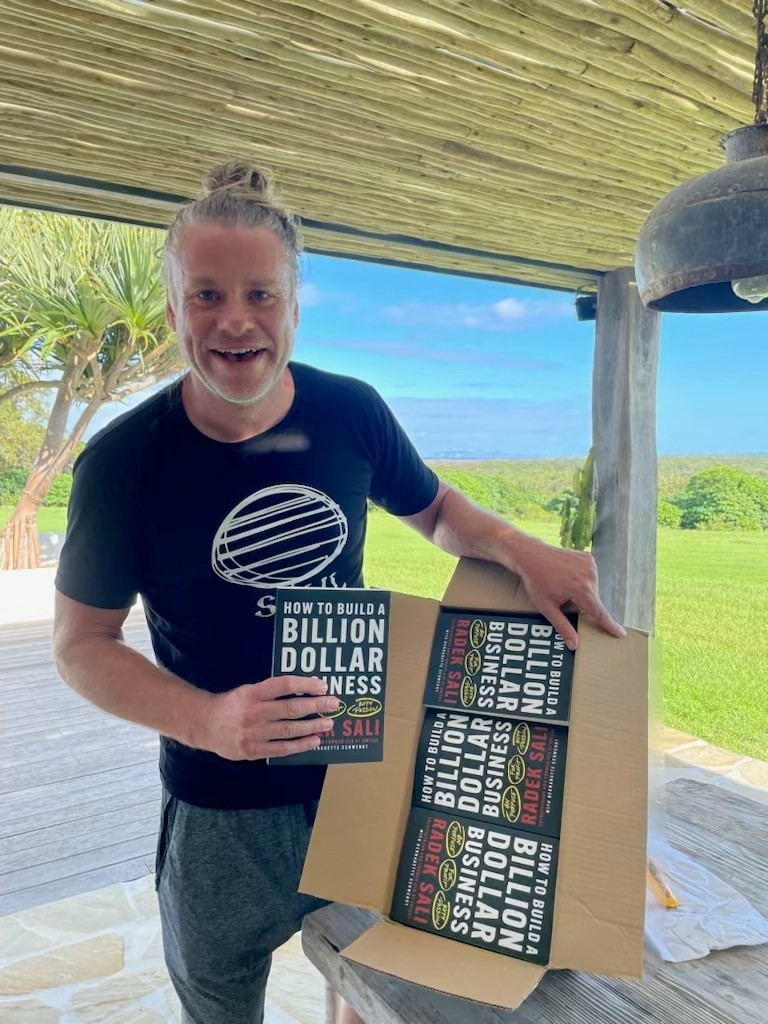
Longevity now carries a certain cultural cachet—its own insider language and status markers. How important is that to moving the field forward?
Health is our most precious asset, and people have always boasted about their routines—whether it’s going to the gym, doing a detox, or training for a marathon. What’s different now is that longevity practices are gaining mainstream recognition. I see it as something to be proud of, and I want to democratise access so everyone can ride the biohacking wave.
But some argue that for the ultra-wealthy, peak health has become a kind of luxury asset—like a private jet or a competitive edge.
That’s short-sighted. Yes, there are extremes, but most biohacking methods are accessible and inexpensive. Look at the blue zones—their lifestyle practices aren’t costly, yet they lead to long, healthy lives. That’s essential knowledge we should be sharing widely, and Wellspring is designed to do that in an engaging way.
Community is often cited as a key factor in healthspan. How does Wellspring foster that?
Community is at the heart of it. Just as Okinawa thrives on social connection, we want Wellspring to be a regular gathering place where people uplift each other. Ideally, it would become as busy as a Live Nation schedule—but for health and wellness.
Do you worry longevity could deepen class divides?
Class divides exist, and health isn’t immune. But in Australia, we’re fortunate—democracy and a strong equalisation process help maintain quality of life for most. Proactive healthcare, like supplementation and lifestyle changes, isn’t expensive. In fact, it’s cheaper than a daily coffee. That’s why we’re one of the top five longest-living nations. The opportunity is to keep improving by making proactive health accessible to everyone.
Some longevity ventures are described as “hedge-fund moonshots.” Others, like Wellspring, seem grounded in time-tested approaches. Where do you stand?
There’s value in both, but I’m more interested in sensible, sustainable practices. Things like exercise, meditation, and community-driven activities are proven to extend life and improve wellbeing. Technology can support this, but we can’t lose sight of the human elements—connection, balance, and purpose.
Finally, what role can Australia—and Wellspring—play in shaping the global longevity conversation?
The fact that we can put on an event like Wellspring, attract world-leading talent, and already have commitments for future years says a lot. Australia is far away, but that hasn’t stopped great scientists and thinkers from coming. We’ll be here every year, contributing to the global conversation and, hopefully, helping more people extend their healthspan.
You may also like.
‘Continuum’ Opens to Rave Applause at Sydney Dance Company
Rafael Bonachela’s latest curatorial triumph premiered last night at the Roslyn Packer Theatre, dazzling audiences with its emotional range and fearless physicality.
Sydney Dance Company opened its latest season with Continuum, a triple bill that reminds audiences why the ensemble remains Australia’s most compelling cultural export. Receiving a standing ovation at its premiere last night at the Roslyn Packer Theatre, the program unfolds as an elegant meditation on movement and metamorphosis—three distinct choreographic visions held together by Rafael Bonachela’s curatorial precision and instinct for contrast.
Stephen Page’s Unungkati Yantatja – one with the other breathes land, sea, and sky into motion; Tra Mi Dinh’s Somewhere between ten and fourteen lingers in the tender light between day and night; and Bonachela’s own world-premiere Spell delivers the evening’s visceral heartbeat. Together they trace the continuum of life itself—fluid, volatile, and impossible to pin down. Running through 1 November, the production affirms Bonachela’s vision of dance as “an ever-evolving conversation between artists, audiences, and the world around them.” Robb Report ANZ recently caught up with Bonachela.
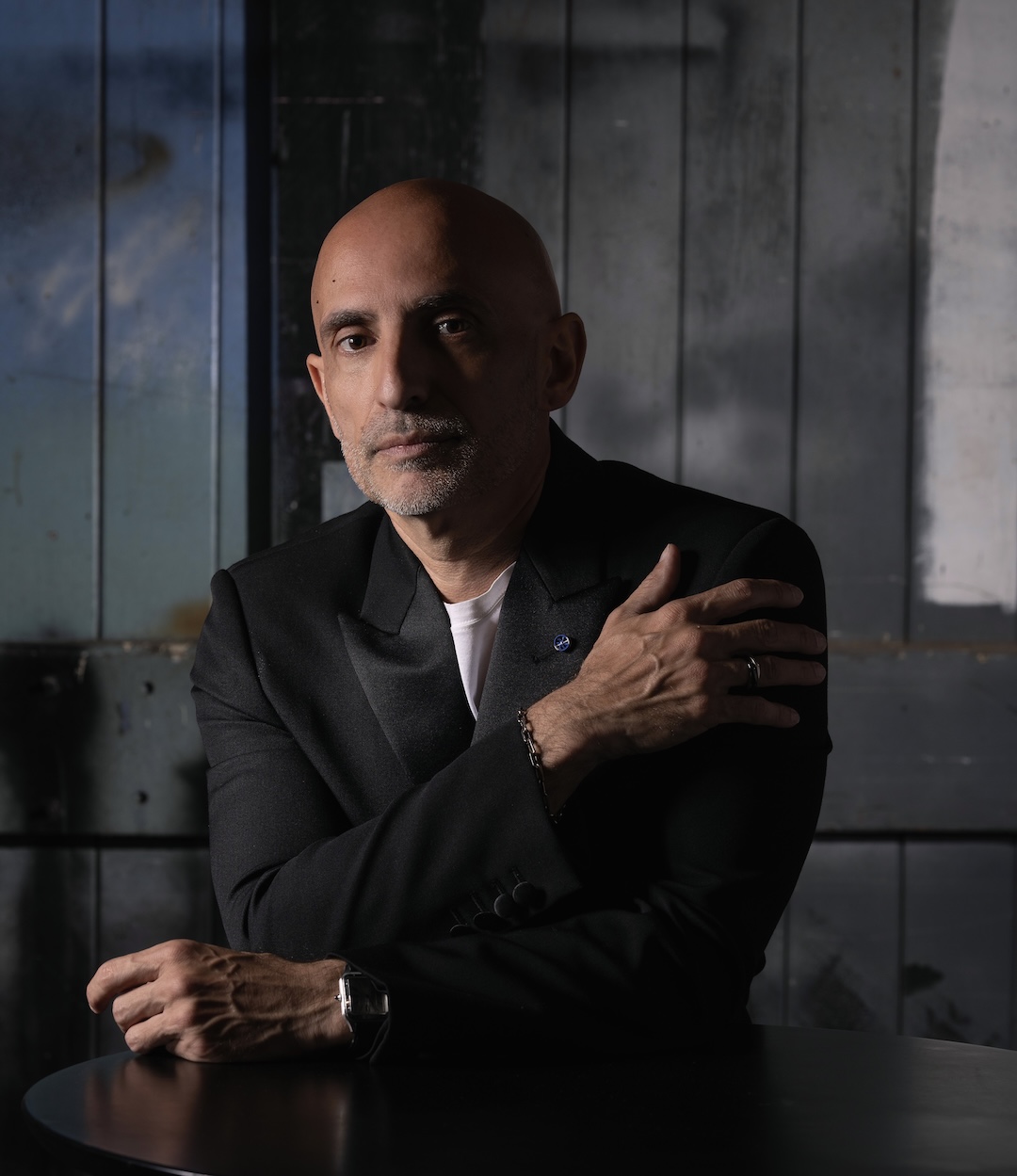
Continuum is described as “a bold exploration of the ever-shifting cadence that binds us to the world.” How did this idea of constant transformation influence your choreographic choices in Continuum?
I’ve curated this evening as an invitation for audiences to experience dance as an ever-evolving conversation—between past and present, between the individual and the collective, and between diverse artistic voices. My intention with this program is to spark connection, curiosity, and reflection, offering works that challenge, move, and inspire while revealing the transformative power of the body in motion.
Each choreographer brings a distinct perspective, yet all share a commitment to exploring the body in motion as a vessel for transformation. Through contrasting aesthetics, cultural resonances, and shifts in time, these works reveal how dance exists on a continuum—where moments build upon one another, find new meanings in fresh contexts, and affirm the enduring power of the human form to express what words cannot.
You’ve created the world premiere Spell within Continuum, which explores “the limits of emotional and physical expression.” What did you aim to conjure emotionally and physically through Spell, and how does it dialogue with the other works in the triple bill?
The title Spell itself suggests a duality—it can be something magical, but also something we fall under without even realising. Emotionally, I want to evoke an atmosphere that is at once intimate and volatile, where vulnerability and power exist side by side. There’s a ritualistic quality to the work, as if the dancers are caught inside a force they cannot quite escape—and it’s that tension which drives the movement and fuels the piece.
Within Continuum, Spell emerges as an intense, visceral heart—both contrasting with and speaking to the other works. While it shares the evening’s theme of transformation, it explores it through a lens of emotional ignition and fearless physicality.
In crafting Continuum, how did you balance moments of intimacy and expansiveness—especially when layering live elements like music and immersive lighting—to evoke that ebb and flow of life’s narratives?
In Continuum, each choreographer works with complete artistic freedom, without any direction from me. That independence brings out authentic contrasts and unexpected connections between the works. It’s this variety that invites audiences to engage on their own terms, discovering personal meanings and emotional threads that are unique to each viewer.
This triple bill seems to offer a journey through time and place—from twilight’s fleeting beauty to elemental breath. How do you want audiences to experience—and perhaps rethink—the relationship between movement, nature, and storytelling?
I always want audiences to come with an open mind and allow the experience to be unprescribed free to discover their own meanings and narratives. Dance has the unique power to be felt as much as it is seen, to resonate physically and emotionally in ways words can’t. I hope audiences leave with a renewed sense of how deeply movement is connected to the natural world, and how it can tell stories without language. Like nature, this evening is always in motion—emerging, transforming, and fading—so that each work becomes a landscape the audience can journey through, sensing their own place in the continuum of life
Looking ahead, does Continuum carve out a new direction or personal milestone for your artistic trajectory? What might this signal for your future choreographic explorations?
Continuum feels like both a culmination and a starting point. It gathers threads from my past work, my fascination with transformation, my love of collaboration, my search for emotional truth and weaves them into something that opens new doors.
Creating and curating this triple bill has changed how I see works interacting—how contrasting voices can strengthen shared themes. It’s inspired me to explore even more fluid boundaries between ideas, styles, and disciplines.
If it signals anything for the future, it’s that I’m interested in going further into that space where dance is not just movement, but an ongoing conversation—between artists, between forms, and between audiences and the world around them.
Continuum runs through November 1 at the Roslyn Packer Theatre.
You may also like.
Inside the $30 Billion Obsession Among the Ultra-Wealthy : A Race to Live Longer
The pursuit of an extended life has become a new asset class for those who already own the jets, the vineyards, and the art collections. The only precious resource left to conquer, it seems, is time.
If you want to know what the latest obsession is these days among the ultra-wealthy, listen in at dinner.
Once it was crypto, then came AI and psychedelics, now it’s longevity all the time. The talk is of biomarkers, NAD+ levels, and methylation clocks, of senolytics and stem cells. Guests compare blood panels like wine lists, and the most important name to drop is no longer your banker or contact at Rolex but your longevity physician. For those just arriving at the conversation, the new science can sound like science fiction—but it’s fast becoming the lingua franca of money.
The field has its own vocabulary—epigenetic reprogramming, which aims to reset cellular clocks; cellular senescence clearance, the removal of “zombie” cells that clog our systems as we age; precision gene therapies, designed to personalise interventions at the level of DNA—that sounds equal parts Brave New World and Wall Street pitch deck. But make no mistake: this is no longer a niche pursuit. The sector is already worth an estimated $30 billion globally and projected to surpass $120 billion within the decade, having attracted billions in investment from the likes of Altos Labs, Juvenescence and Google-backed Calico. Tech titans and old-money families alike are staking claims on the possibility of an extra decade or two. It’s a space where venture funds court Nobel laureates, hedge funds bankroll gene-therapy moonshots, and even wellness festivals in Australia draw rock-star scientists to the stage.
The Poster Child and the Pitch
David Sinclair, the Sydney-born Harvard geneticist who has become something of a poster child for the field, is quick to underline the stakes. “We’re not just talking about lifespan, we’re talking about health span,” he tells Robb Report. “Extending the number of years people live well—without frailty, without disease—isn’t just a medical breakthrough. It’s a social and economic one.” Sinclair, whose research ranges from NAD boosters to epigenetic age-reversal therapies, has calculated that adding a single year of healthy life to the US population, for example, could be worth $38 trillion in economic benefit—fewer years of costly aged care, less burden on hospitals, more years of productivity and compounding returns. In other words, the dividends of health are financial as well as personal. “That’s why governments and investors are paying attention,” he says.
Sinclair has become a fixture on the global circuit, drawing crowds that rival TED or Davos. As Radek Sali, the Australian entrepreneur behind the new Wanderlust Wellspring longevity festival taking place on the Gold Coast this October, where Sinclair is the keynote speaker, puts it: “Wellness has moved into the realm of entertainment.” At Wellspring, platinum-tier guests pay up to nearly $2,000 for the privilege of hearing scientists and investors share the stage over a weekend like headliners at Coachella.
Investing in Time
And then there are the sideshows. Bryan Johnson, the tech mogul turned human guinea pig, makes headlines with his open-source, organ-by-organ data tracking—his infamous “penis readings” have become cocktail-party fodder. While many dismiss him as a parody of the field, his multimillion-dollar project Blueprint has nevertheless made longevity impossible to ignore in the mainstream.
For the uninitiated, the science of longevity today is no longer about vitamin salesmen or fringe dietary regimes. This is the new frontier—one where biology is not just observed but engineered, and where investors smell opportunity on par with space travel. It’s little wonder that Altos Labs has raised billions to chase cellular rejuvenation, or that Juvenescence has secured more than $400 million to fast-track therapies. What was once the realm of eccentric tinkerers now attracts sovereign wealth funds.
“This body takes me to meetings, earns me money—why not invest time and money into it?”
The appeal to the One Percent is obvious. Longevity is a natural extension of portfolio thinking: diversify your assets, hedge your risks, and above all, maximise return on investment. Except in this case, the returns are measured in years of health, energy and cognition. As Andrew Banks, a Sydney-based entrepreneur and early investor in Juvenescence, explains: “This body takes me to meetings, earns me money—why not invest time and money into it?” His Point Piper home teems with contraptions—a Reoxy breathing machine, hydrogen therapy, red-light sauna, and he spends a few hours a day on maintenance, as if his body were a private equity stake.
Banks, like others in his cohort, is baffled that more wealthy men haven’t followed suit. “Entrepreneurs pride themselves on divergent thinking,” he says. “They expand, dream and create businesses with it. But when it comes to their bodies, they’re convergent—unimaginative. The lack of curiosity is astonishing to me.”
Medicine 3.0 and the New Rituals
Steve Grace, a Sydney-based entrepreneur and the proprietor of exclusive private networking club The Pillars, which is opening a longevity program, thinks there is a reckoning coming for those who do not take matters into their own hands. “As someone who has run a few recruitment businesses,” he says, “I can tell you that if you’re a man or woman in your 50s and working as an employee, even in a really good position, it’s time to get worried about job security and being aged out of the workforce. You have to make yourself as vital as possible and become the best version of yourself, or you’re toast.”
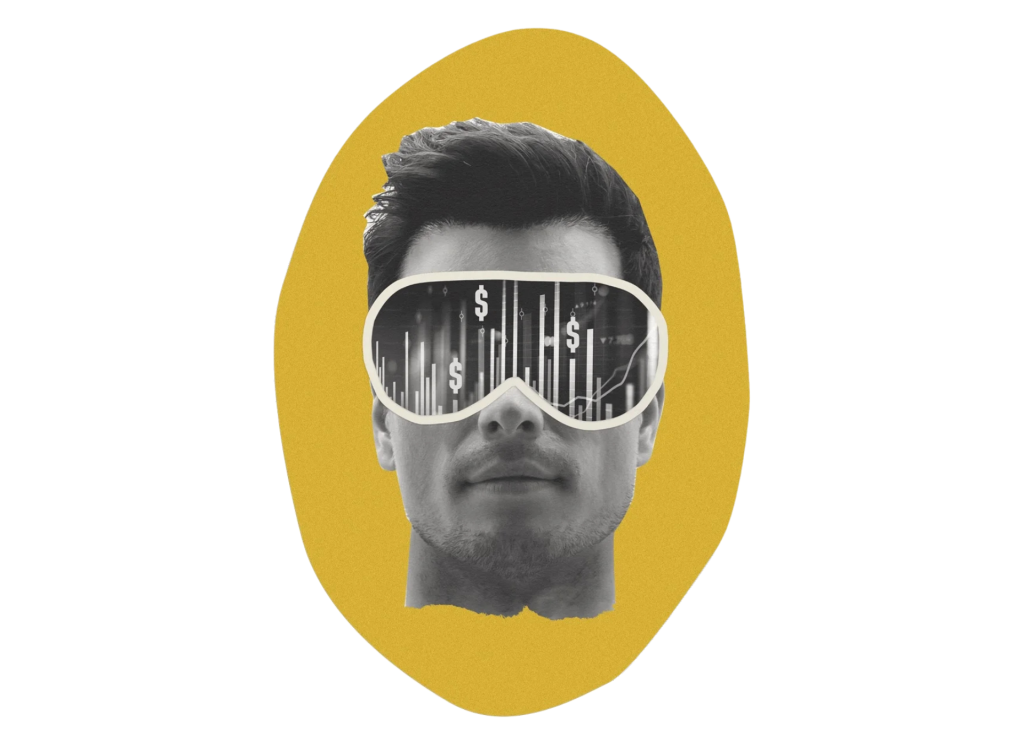
What was once fringe has now become a cultural necessity for those who can afford anything, with science finally catching up to ambition. Sinclair’s lab at Harvard recently published a study on the reversibility of cellular ageing—restoring vision in blind mice and setting the stage for human trials in conditions like glaucoma. In Boston, his company Life Biosciences will begin treating patients with blindness in a Phase I trial using partial cellular reprogramming early next year. “This isn’t science fiction anymore,” Sinclair says. “We’re at the point where we can reprogram cells, turn back their biological clocks, and restore function.”
Meanwhile, practitioners like Dr. Adam Brown of the Longevity Institute in the Sydney suburb of Double Bay are reinventing diagnostics. His “assessment menu” has been compared—only half-jokingly—to a Michelin Guide for medical testing: full-body MRI scans, continuous glucose monitors, polygenic risk scores. “What we do is proactive, not reactive,” he says. “Correct deficiencies first, then optimise health. That’s how you get peak performance in the short term and resilience in the long term.” Brown frames longevity in terms that would resonate with any investor: “There’s a short-term ROI—fixing glucose or sleep issues so you perform better tomorrow. And there’s a long-term ROI—functioning in your 70s as you would in your 40s. That’s extending your career, your income potential and your independence.”
“Once upon a time, male vanity meant injectables, veneers and a tan. Today, it’s VO2 max scores and continuous glucose monitor readouts.”
Peter Attia, the Canadian-American physician and podcast host who has helped popularise the concept of “Medicine 3.0”, echoes this emphasis. Medicine 1.0, according to him, was about surviving infections. Medicine 2.0 was about treating chronic disease. Medicine 3.0 is about staying ahead of decline: measuring, monitoring and intervening early. “The goal is not just to avoid disease but to lengthen health span,” Attia has said.
For those already converted, longevity is less about lab science than daily rituals. Sydney-based Chief Brabon, who trains CEOs like athletes, says: “These men are like Formula One cars—you don’t wait until the tyres are bald before swapping them. You keep everything tuned, precise, optimised.”
That tuning now involves more gadgets than ever: hyperbaric oxygen chambers, cryotherapy, sauna/cold-plunge circuits, peptide stacks, nootropics. And yes, a glut of supplements, some with evidence, others little more than wishful thinking. Once upon a time, male vanity meant injectables, veneers and a tan. Today, it’s VO2 max scores and continuous glucose monitor readouts. “Health is the new flex,” as Steve Grace quipped, glancing at his wrist-worn biometric tracker.
The New Flex: Health as the Ultimate Luxury
Still, there is plenty of scepticism. Some therapies are unproven, others prohibitively expensive. And there is the unavoidable fact that many leading scientists, including Sinclair, have stakes in companies producing supplements and therapeutics, raising eyebrows about conflicts of interest. “The difference,” Sinclair insists, “is whether it’s backed by peer-reviewed science and measurable biomarkers. If it can’t be quantified, it’s marketing, not medicine.”
Then there are the contradictions. It promises democratisation while often priced like a private club. It champions science but thrives on hype. It seeks to extend health span but risks deepening class divides. “Only if we let it,” Sinclair says when asked if longevity risks becoming the preserve of the wealthy. “Like antibiotics or aspirin, these advances should become widely available and affordable once they scale.” Sali agrees, but from another angle: “Biohacking doesn’t have to be expensive,” he says. “The blue zones prove that—community, diet, movement, purpose. Those are free. Wellspring is about making that knowledge accessible.”
And yet, for all its shortcomings, the movement is here to stay. Investment continues to pour in. Technology—like senolytic drugs that clear aged cells or AI-driven platforms that predict individual disease risk years in advance—is moving from speculation to clinical trial. Scientists are being recast as influencers. And the wealthy, always in search of the next advantage, have found in longevity a pursuit as old as alchemy, yet dressed in the language of venture capital. The truth is that health has always been an asset. What’s new is that it’s now being traded, optimised and measured like one.
In the end, longevity is less about a moonshot than about curiosity. Banks, Sali, Sinclair, Attia are all, in their own way, betting on time. Perhaps the most radical idea is also the simplest: that the best-performing asset in any portfolio is the body itself. Unlike Bitcoin, it carries you to meetings. Unlike art, it cannot be stored in a vault. Unlike real estate, it is non-transferable.
The new calculus of longevity is the recognition that the ultimate luxury is not wealth or status, but a few more decades of clear thought, strong bones and good company—and the ability to make money off it. Everything else, as one investor put it, is just a rounding error.
You may also like.
By Mark Ellwood
04/07/2025
How Sailing Shaped Loro Piana’s Most Iconic Designs
Pier Luigi Loro Piana grew his family textile business into a celebrated fashion house by following his passion for sports on land and at sea.
The Regatta Connection
The race village at Port de Saint-Tropez is awash with people in nautical navy and white, the de facto dress code for the Loro Piana Giraglia regatta. This is the second year the fashion house has lent its name to one of the Mediterranean’s most prestigious summer races. The course zooms from the French coast to Genoa, Italy, taking a sharp turn past Giraglia, a small island off Corsica’s northern tip. It’s the latest in a long line of marine events the brand has sponsored, dating back more than 20 years.
The link between sailing and the brand—and more consequentially the Loro Piana family—is exemplified by the man Robb Report is here to meet: Pier Luigi Loro Piana. An avuncular figure in his 70s with the physique of a man who has enjoyed life, Pier Luigi fell in love with sailing in his late teens, when a family friend took him for a cruise in a sloop.
“Using the wind to go faster or slower, driving the boat like it has an engine, it’s really fascinating,” he says. Inevitably, he started competing. “When you’re sailing, you’re always looking for other boats to go and fight with. It’s an instinct,” he says. And then, with considerable understatement, “I think it’s a nice hobby.”
A Life Under Sail
He currently owns two boats: My Song, which you can see on these pages, is a 25 m sailing yacht that competed in the Regatta. There’s also Masquenada, a comfortable 50 m explorer. It’s a commendable set-up befitting a man who shaped one of Europe’s most celebrated fashion houses.
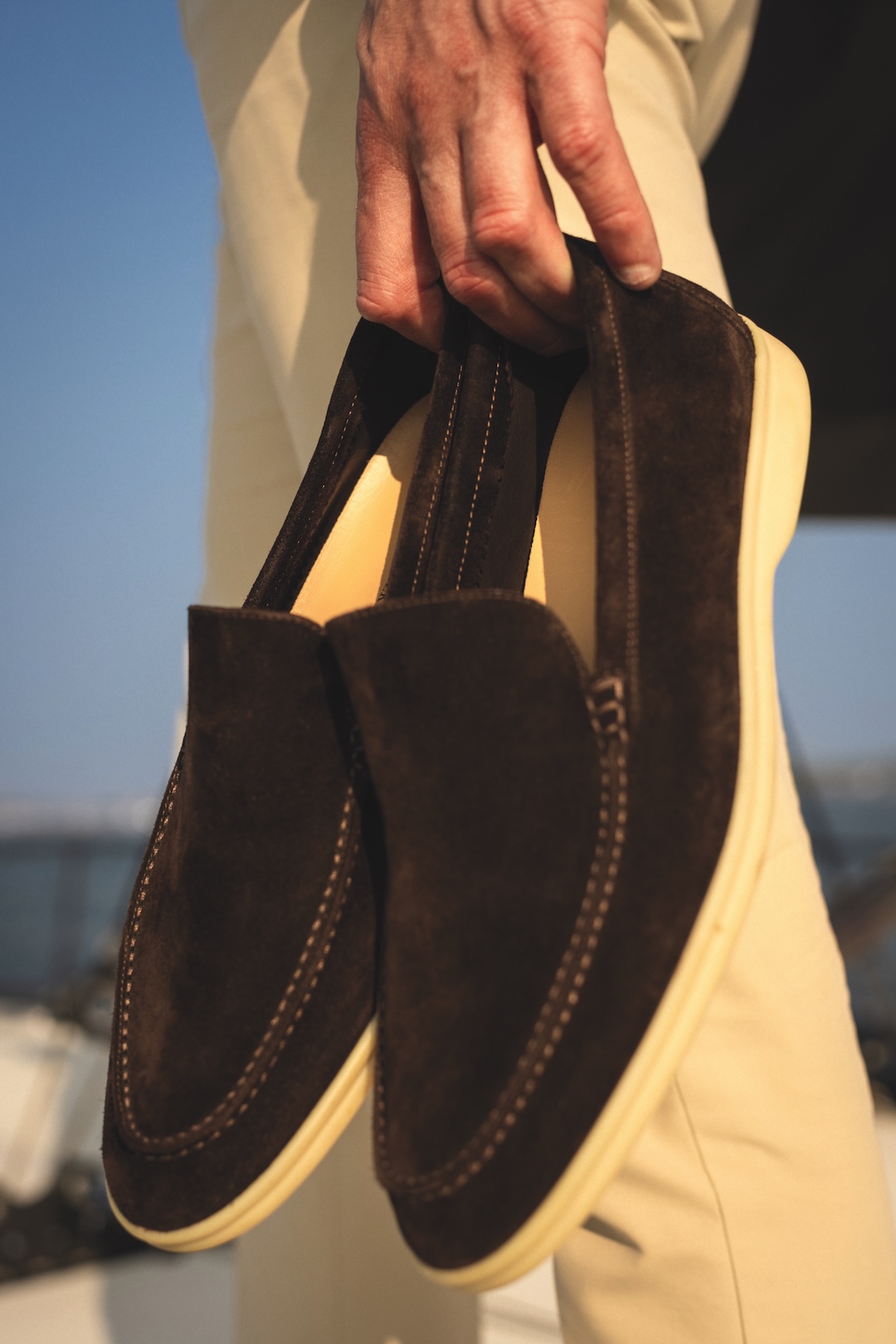
A Family Business Turned Global Powerhouse
The textile and clothing company that bears his family’s name was launched by an ancestor, Pietro Loro Piana, in 1924. A few generations later, Pier Luigi and his brother, Sergio, would run it for four decades until LVMH acquired a majority stake for around $4 billion in 2013. Sergio passed away that year; his widow and Pier Luigi still own a share of the brand between them.
The brothers proved innovative custodians, moving the company upmarket with an insistence on ultra-fine materials and groundbreaking fabrications. And the connection with sports—specifically yachting, horseback riding, skiing and golf—is integral to how the brand positions itself. As Pier Luigi recalls, such associations often had self-serving origins.
“These are the sports my brother and myself were doing,” he says. “We were very committed in business in the 1970s, ’80s, ’90s, so we were like our customers: people that like to work hard but also play hard. And that meant sports.”
Innovation Born of Necessity
This affinity often led them to develop durable, yet elegant, materials and gear for their off-duty pursuits, eventually offering versions to their athletic clientele. “We engineered products with unusual properties, natural fibres like wool or cashmere with a membrane that makes it waterproof and windproof… For research and development, I was the first victim,” he says with a chuckle. Once, he wanted a ski jacket that was “warmer, lighter, softer and better” than nylon models, so he made a prototype to test on the slopes. It gave birth to the Loro Piana Storm System, launched in 1994. The line’s wind-resistant waterproof wool and cashmere has since been used by brands around the world. “I still have this jacket,” he says.
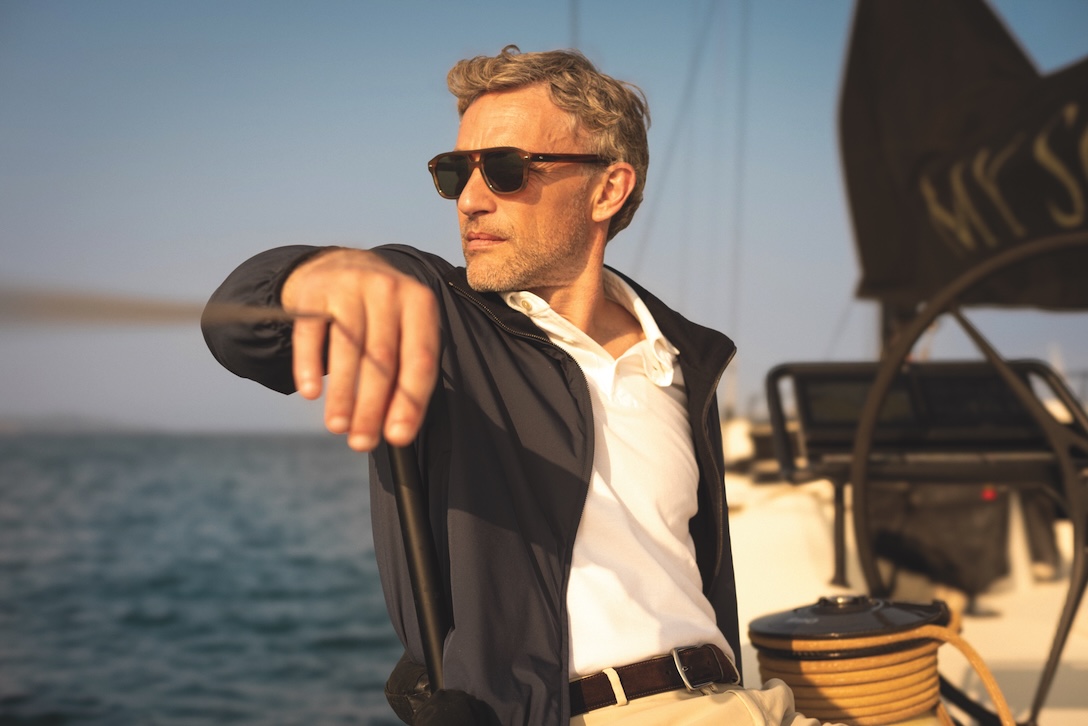
The same process happened on the water. A beloved reversible bomber, with knitted cashmere on one side and waterproof polyester on the other, was born from Pier Luigi’s need for a functional jacket to wear on his yacht. “It’s very light, doesn’t wrinkle, it’s warm, windproof,” he says. “It solves so many problems.”
He takes less credit for perhaps the brand’s most famous—and almost certainly most imitated—product, the white-soled suede Summer Walk loafers. “That was my brother,” he says. “When we were 20, 30 years old, we went sailing and there were only [Sperry] Top-Siders or Sebagos. But when the soles got worn, they got hard and slippery.”
The answer: a non-marking sole with grip—“like a tire you use in Formula 1 when it’s wet”—which Sergio got his bespoke shoemaker to sew to suede uppers. Eventually, they produced two versions: a loafer and the Open Walk, a model with a slightly higher top. “We discovered people were using them also for formal wear because they were so comfortable,” says Pier Luigi. “It’s really a successful story that started from product research.”
And if problem-solving can turn your family business into a giant of global style, clearly it pays to be a little selfish.
You may also like.
13/11/2025
By Brad Nash
18/08/2025
The Supercar of Pool Tables
In a rare fusion of Italian design pedigree and artisanal craftsmanship, Pininfarina and Brandt have reframed the barroom game as aerodynamic high art.
In the rarefied realm where leisure meets design, the latest object of desire doesn’t purr down the autostrada—it commands the room from a single sculptural base. The Vici pool table, a collaboration between Italian automotive legend Pininfarina and Miami’s bespoke table-maker Brandt Design Studio, reimagines the game with the same aerodynamic poise and artisanal precision that have graced some of the world’s most beautiful vehicles.
Named for Julius Caesar’s immortal boast—“Veni, vidi, vici”—this limited-edition series transforms billiards from casual diversion into a declaration of style. Every curve is deliberate, from the ultra-thin playing surface clad in tournament-grade Simonis cloth to the seamless integration of Italian nubuck leather and precision-milled metals. The effect is more haute sculpture than barroom pastime—yet it meets exacting professional standards.
For the true connoisseur, the debut PF 95 Anniversario edition celebrates Pininfarina’s 95-year legacy in just 95 numbered pieces. Finished in dark-blue lacquer with rose-gold accents and a flash of red felt, each table is discreetly nameplated—a tangible claim to an heirloom in the making.
“It’s not just about how it plays—it’s about how it lives in a space,” says Dan Brandt, the master craftsman whose work has long graced the world’s most exclusive interiors. Whether anchoring a penthouse salon, a members’ lounge or the main deck of a superyacht, the Vici is designed to stir conversation before the first break.
For those accustomed to Pininfarina’s sleek automotive silhouettes, this is a chance to bring that same lineage of movement, form and Italian refinement into the home. Only now, the horsepower is measured not in engines—but in the geometry of a perfect shot.
From pool to midcentury to Ottoman, we’ve got all the table angles covered at Robb Report Australia & New Zealand —plus more home-worthy pieces.






